
Arriving in
November
Shanghai,
1938
Horst (Peter) Eisfelder
Registered by Australia Post. Publication No. VBH 7236 The magazine of the Jewish Holocaust Centre, Melbourne, Australia
April 2016 Jewish Holocaust Centre
JHC Board:
Co-Presidents: Pauline Rockman OAM & Sue Hampel OAM,

Immediate Past President:
Shmuel Rosenkranz
Secretary: Elly Brooks
Treasurer: David Cohen
Members: Goldie Birch, Allen Brostek, Alex Dafner, Abram Goldberg OAM, Paul Kegen, Helen Mahemoff, Viv Parry, Richard Michaels, Mary Slade, Willy Lermer
JHC Foundation:
Chairperson: Helen Mahemoff
Trustees:
Nina Bassat AM
Joey Borensztajn
Allen Brostek
David Cohen
Jeffrey Mahemoff AO
Patrons:
Professor Yehuda Bauer
Mrs Eva Besen AO
Mr Marc Besen AO
Sir William Deane AC CBE
Sir Gustav Nossal AC CBE
Mrs Diane Shteinman AM
Steven Spielberg
JHC
On the cover:
Luba Goldberg with her granddaughter
Lucy Korman at a Memory Reconstruction Project workshop held at the Jewish Holocaust Centre in December 2015
The Jewish Holocaust Centre is dedicated to the memory of the six million Jews murdered by the Nazis and their collaborators between 1933 and 1945.
We consider the finest memorial to all victims of racist policies to be an educational program which aims to combat antisemitism, racism and prejudice in the community and fosters understanding between people.
IN THIS ISSUE
13–15 Selwyn Street
Elsternwick Vic 3185
Australia
t: (03) 9528 1985
f: (03) 9528 3758
e: admin@jhc.org.au
w: www.jhc.org.au
OPENING HOURS
Mon–Thu: 10am–4pm Fri: 10am–2pm
Sun & Public Hols: 12pm–4pm
Closed on Saturdays, Jewish Holy Days and some Public Holidays
Disclaimer: The opinions expressed in Centre News are those of the authors and do not necessarily reflect those of the magazine editor or editorial committee. While Centre News welcomes ideas, articles, photos, poetry and letters, it reserves the right to accept or reject material. There is no automatic acceptance of submissions.
JHC Centre News 2
Photo: Lori Shocket
This publication has been designed and produced by Izigraphics Pty Ltd www.izigraphics.com.au
Staff: Warren Fineberg,
Lisa Phillips,
Jayne Josem,
Collections Michael Cohen, Director of
and Research Michelle Malet, Director of
& Director of Advancement Reuben Zylberszpic, Development Manager Phillip Maisel OAM, Head of Testimonies Project Robbie Simons, Testimonies Assistant Coordinator / Audio-visual Producer Fiona Kelmann, Education Officer Rae Silverstein, Volunteer Coordinator Claude Fromm, Assistant Archivist Daniel Feldman, Project Administrator Julia Reichstein, Librarian / Information Manager Lena Fiszman, Office and IT Manager Tosca Birnbaum, Reception Centre News Editor: Ruth Mushin From the Presidents 3 Editor’s letter 3 Director’s cut 4 Education 4 Introducing Michelle Malet 5 Jewish Holocaust Centre receives Multicultural Excellence Award 5 Memory Reconstruction: a sacred culture rebuilt 6 Remembering the ‘Angel of Life’ 8 Art as witness 10 Saba Feniger: abandoned at sea 12 The IHRA meets in Hungary 13 The Holocaust, culture and complicity – then and now 14 Reflections on the ‘Jewish Refugees and Shanghai’ exhibition 16 Remembering life in Shanghai 17 L’dor va’dor: Holocaust memorial museums and the intergenerational transmission of memory 18 The Interior of Our Memories is launched at the Jewish Holocaust Centre 20 Farewell to the JHC 21 The ‘New Australians’ 2 2 JHC Social Club 24 Friends of the Jewish Holocaust Centre 25 Seen around the Centre 26 How to access the Shoah Foundation Archive 2 8 New acquisitions 2 9 Bequests 30 How you can support the JHC 3 2 Community news 3 6
Executive Director
Director of Education
Curator, Head of
Community Relations
Foundation
FROM THE PRESIDENTS PAULINE ROCKMAN OAM & SUE HAMPEL OAM
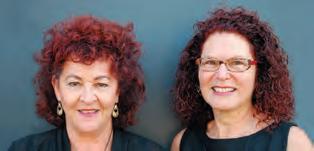
It has been wonderful to watch the progress of the Jewish Holocaust Centre (JHC) over the past decade. Ten years ago, we were in a transition process, bringing in new staff to continue the work of the survivors who had run the Centre from its establishment in 1984. We had a deep awareness of the legacy the survivors had bequeathed to our generation and, together with them, we sought the delicate balance between following the ideals of the survivor-founders and dealing with the realities of today, as well as planning for the future.
As part of this process, members of the second and third generations of Holocaust survivors are now involved in our Centre. There are currently three representatives of the third generation on our Board – Richard Michaels, Paul Kegen and Treasurer David (Doov) Cohen.
This year we are focused on maintaining the important work that is carried out at the Centre and moving ahead with plans for our urgently needed new building. It is indeed a very exciting time.
We have been involved in meeting museum designers who have presented their case for designing the new museum. One of the questions we posed to the potential designers was: ‘What draws you to be involved in a project such as ours?’ Those presenting included players on the big stage of museum design both in Australia and overseas. All talked about the necessity and urgency to tell the world about the Holocaust and the importance of the work of the JHC, especially in the context of today’s world events. The passion of their responses was inspirational.
In 2015 Australia was granted observer status on the International Holocaust Remembrance Alliance (IHRA). The Australian government chose eight experts to represent Australia, including four from the JHC: the two of us, together with Deakin University academics, Dr Donna-Lee Frieze and Dr

EDITOR’S NOTE
Despite suffering unspeakable horrors during the Second World War, Holocaust survivor and Jewish Holocaust Centre guide Moshe Fiszman, in his address at UN Holocaust Memorial Day, chose to focus on the ‘sparks of human kindness, selflessness and compassion’ by sharing his memories of one courageous non-Jewish woman who helped him to survive. As well as bringing you his moving testimony, we also feature the account of Saba Feniger’s liberation in May 1945, and Fred Antman’s recollections of life as a refugee in Shanghai.
Words are not the only way to tell stories, however, and in this edition we also feature the Memory Reconstruction Project, which brought together Holocaust survivors and their families
Steve Cooke, both of whom are involved in research at the JHC. You can read more about the IHRA elsewhere in this issue of Centre News
One of the pillars of the IHRA is the annual commemoration on 27 January of International Holocaust Remembrance Day, designated by United Nations (UN) General Assembly resolution that marks the date in 1945 when Soviet troops liberated the Nazi death camp at Auschwitz-Birkenau.
Every year the Centre commemorates this important event in line with the UN-designated theme for that year. The Centre has always taken the lead in this venture, but this year we were delighted to host this event together with the Jewish Community Council of Victoria. His Excellency, Dr Helmut Böck, Ambassador to the Republic of Austria, treated us to an inspiring keynote address. In addition, Dr Lachlan Strahan, First Assistant Secretary, Multilateral Policy Division from the Department of Foreign Affairs, spoke about the theme ‘The Holocaust and Human Dignity’. We look forward to this event becoming part of the Australian calendar, for the whole Australian community.
The JHC may not look as it did when the founders opened the doors in March 1984, but the lessons they aspired to teach about the ramifications of racism and hatred are as relevant today –perhaps more so – with antisemitism and racism rearing their ugly heads once again.
Our aim is to increase the general community’s understanding and awareness of the Holocaust and its implications for today. We strive to teach respect of the other, the importance of confronting and fighting racism, of not being a bystander, and having the courage to stand up for humanity. This is work we must all do together.
Chag sameach
at the Jewish Holocaust Centre to create personal collages to capture survivors’ stories. And, in another example of visual story telling, Dr Anna Hirsh discusses some of the artworks housed in the Centre’s own wonderful collection of paintings, drawings and sculpture.
Dr John Fox has written a thoughtful analysis of Theodore Adorno’s ideas about collective responsibility and their connection to the Holocaust, and Dr Avril Alba discusses the transmission of Holocaust memory to successive generations, and the role of Holocaust museums in doing so.
I hope you enjoy the balance of personal stories and more analytical texts, as well as our ‘new look’ design.
JHC Centre News 3
RUTH MUSHIN
DIRECTOR’S CUT WARREN FINEBERG
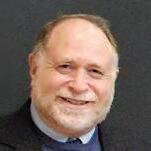
Often when I walk through the Jewish Holocaust Centre (JHC) museum I am surprised by a note I had not read, a new artefact on display, or a photograph viewed in a different way. Recently, I had one such surprise when I noticed a family group of three generations being guided through the museum, in French. Just an hour or so later, I heard a different guide with a new group of visitors, was also guiding in French. What a treat it was to listen to child survivors John Lamovie and Henri Korn offering such a wonderful service to our overseas visitors. I have been delighted to hear guides speaking Greek, Russian, Hebrew, Czech, Polish, German, Italian, Yiddish and Hungarian, but I am sure there are other languages we could add to this list.
Many readers participated in the Memory Reconstruction Project, which is featured in this edition of Centre News. As well as involving those who attended workshops at the Centre, we have also reached out to those who were unable to attend the Centre.
EDUCATION LISA PHILLIPS
The Centre’s Education program is a hive of activity throughout the school year. In 2015, 21,000 students from a diverse range of Victorian and interstate schools participated. In one group of 45 students, 39 language groups were represented. Despite the diversity of students that visit the Centre, all manage to connect and take away valuable lessons about the dangers of hatred, racism and prejudice. This is clearly reflected on our comments board. We do not always see the long-term impact of our work, so I was delighted to hear from Rosebud Secondary College’s School Captain, Alex Dellaportas, who choreographed a performance on the Holocaust, based on her visit to the Centre. This performance won the prestigious ‘Wakakirri National Story of the Year’ award for the Secondary Schools challenge.
Alex wrote:
Thank you for all the amazing work the Holocaust museum does. Education really does make a difference and I can definitely say that our story was inspired in part by both the lovely survivor I met on a tour of the museum a couple of years ago and the things I learnt about the Holocaust during our tour of the Centre.
These comments highlight the importance of our work and the


This work complements our extensive collection of testimonies and interviews, enabling us to keep the stories of survivors alive and accessible to students and other visitors.
Last December, the JHC received a Victoria Multicultural Education Award for its ‘Hide and Seek: Stories of Survival’ program. The program was supported by Vedran Drakulic and Nicole Britain from Gandel Philanthropy. Its success has encouraged us to develop further modules which you will hear about over the course of this year.
Our popular web page requires updating. We have received wonderful financial support from the JHC Foundation and Telematics to commence this work, and Child Survivors of the Holocaust have received funds to assist in incorporating a dedicated child survivors’ section. We also plan to link the web page to our new search engine, providing access to a wealth of information on our databases.
impact of our dedicated survivors and volunteer guides on making a difference to the outlook of young people every day.
Last year, our education team attended three teacher conferences: the History Teachers’ Association of Victoria (HTAV), the History Teachers’ Association of Australia (HTAA), and the Victorian Association for the Teaching of English (VATE). These conferences are vital for reaching teachers and discussing how best to deliver Holocaust education. Our presence at these conferences allows us to help teachers with resources and text selection. Sue Hampel and I also presented workshops at each conference exploring online approaches to the Holocaust, issues of historical representation of the Holocaust in film, and the text Maus. Each was highly successful, and we are continuing to participate and submit workshop ideas this year.
The Australian curriculum is constantly evolving, so we too need to adapt to meet the needs of schools and maintain our relevance. It was gratifying that our ‘Hide and Seek: Stories of Survival’ program was awarded the Multicultural Award for Excellence in Education 2015 by the Victorian Government. There are so many people who have contributed to the success of this program, a true reflection of the collaboration and teamwork that exists at the Centre.
JHC Centre News 4
Introducing Michelle Malet

It is a pleasure to serve as the Centre’s recently appointed Director of Foundation and Director of Advancement. I hold a Master of Social Work from the University of Pennsylvania and a Master of Arts in Jewish Communal Service from Gratz College, and bring to this position extensive experience working with Jewish organisations, together with a deep-seated passion for Jewish communal building.
More than three years ago I made the move from the US to Melbourne, with my husband David and two daughters, Erica and Olivia.
While serving as the Director of Development of Gesher Jewish Day School of Northern Virginia, I successfully guided the $12 million capital campaign for the opening of the new school campus. As a Senior Campaign Associate at the Jewish Federation of Greater Washington, I led the $1.4 million Community Campaign, served as the liaison to 60 Greater Washington synagogues, and developed educational training symposia for congregational leaders and fundraising appeals for synagogues. I have also worked in university philanthropy, both at the George Washington University and most recently at the University of Melbourne.
The Jewish Holocaust Centre (JHC) is a remarkable institution. Working mainly in Jewish philanthropy for the past twenty years, with a career that has included raising resources for Israel, American Jewish communal needs and Jewish education, I have yet to come across an organisation with such a compelling and emotional mission, unique purpose and ability to inspire change. Philanthropy is all about inspiring change.
Through its education program, the JHC challenges students on a daily basis. Students confront the important issues of prejudice, racism and intolerance and learn the values that are essential for living in a democratic and multicultural society.
JHC receives Victorian Multicultural Excellence Award
The Jewish Holocaust Centre is delighted to have received a Victorian Multicultural Excellence Award for its ‘Hide and Seek: Stories of Survival’ education program.
Coordinated by the Victorian Multicultural Commission (VMC), the Multicultural Awards for Excellence honour recipients for their outstanding contributions to Victoria’s multicultural community. The Centre’s award was for ‘Outstanding practices in education services that raise awareness and support the implementation of civics, citizenship and multicultural education.’
The award was presented to the Jewish Holocaust Centre’s Director of Education, Lisa Phillips, by the Governor of Victoria, The Hon Linda Dessau AM, at a ceremony at Goverment House in December 2015.

It is an honour and privilege to be a part of this outstanding organisation which commemorates the legacy of our treasured Holocaust survivors and inspires visitors to change the future.
The Centre has an impressive tradition of communal support. We are extremely fortunate to have significant long-term financial security through the Jewish Holocaust Centre Foundation. I am delighted to work very closely with Helen Mahemoff, Chairperson of the Foundation. Together with the JHC Executive, we are undertaking preparations for the Centre’s upcoming Capital Campaign.
We shall be launching several new fundraising initiatives which are detailed in the Donor Recognition section of this magazine. Specifically, I am pleased to expand the Foundation’s ‘Partners in Remembrance Giving’ program to incorporate major donors to the Centre, as well as initiate a Bequest Society and the Circle of Remembrance Annual Appeal.
During the feasibility study for the Capital Campaign I have enjoyed meeting with many of our philanthropic supporters, and look forward to meeting many more families and friends during the year.
The Middle school program ‘Hide and Seek, Stories of Survival’ allows younger students from Years 5 to 8 to explore the Holocaust through age-appropriate experiential learning activities.
JHC Centre News 5
(l-r) Lisa Phillips, The Hon Linda Dessau AM, Sue Hampel OAM, Warren Fineberg and Nicole Brittain




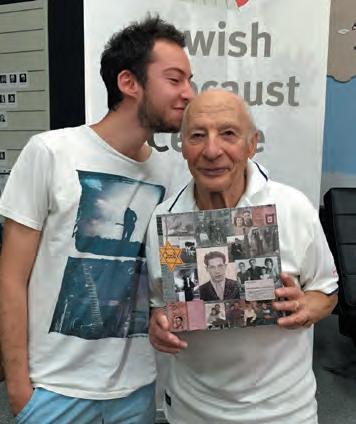

JHC Centre News 6 1 2
4 5 6
3
1 Nurit Borsky and Mookie Bialylew 2 Joe de Haan and grandson 3 Sarah Saaroni and Lori Shocket 4 Henri Korn and family 5 Moshe and Franciska Fiszman 6 Mary Slade and family 7 Rosemary Benkemoun and Anatie Livnat 8 Richard Michaels and Regine Szmulewicz 9 Aron Sokolowicz collage 10 A collage in progress 11 Rae Silverstein and daughter
Memory Reconstruction: a sacred culture rebuilt
In December 2015, Holocaust survivors and their families participated in a series of workshops to create personal collages to capture survivors’ stories. The workshops, held at the Jewish Holocaust Centre (JHC) for JHC volunteers, were run by Los Angeles artist Lori Shocket, creator of the Human Element Project.



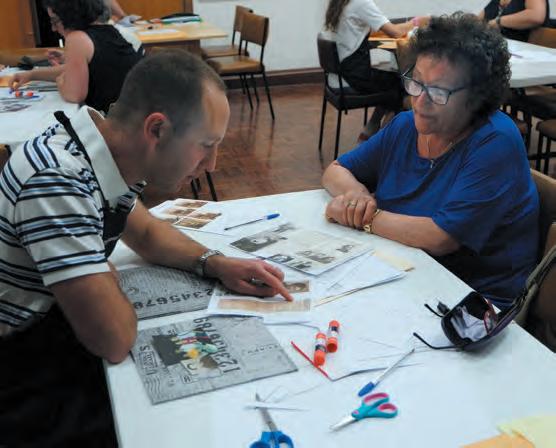

Holocaust survivors and their families gathered memorabilia from household cupboards, shoeboxes and family albums to design collages showcasing intensely personal narratives of destruction and survival. The project took Holocaust remembrance beyond the generalised platitude of ‘never forget’ and gave participants the opportunity to delve into intensely personal stories, honouring survivors, their families and their journeys. Their collages provide a lasting legacy for survivors and their families, and reproductions of each collage will form an installation at the Jewish Holocaust Centre.
The Human Element Project was more than I had imagined. At first glance it seemed to be a regular art workshop; after a short while it became evident this was so much more. The Holocaust is a difficult subject still for so many survivors, but here they were surrounded by their sons, daughters and grandchildren, all contributing in whatever way they could to produce a collage of precious photos that told the story of their loved one’s Holocaust journey.
Thank you for your inspirational idea to create a mural of precious memories. You have created a pathway to healing survivors’ pain by validating their traumatic experience and at the same time allowing family members to show their love and respect.
Viv Parry
Thank you for the opportunity to take part in this fabulous project. Going through my parents’ photos, documents, letters and memorabilia over the last few days with my mother, Sara, opened up so much more precious dialogue of her pre-war life in Poland, her painful but inspirational survival story and the resilience of her post-war experience of immigration and establishing a family which now spans four generations. The collages concisely tell this story
Sue Lewis
When I’m sitting here to have the interview I look around and see my children and grandchildren: to me it is a great achievement. I didn’t believe that I will live until my age at 86 and can still tell my stories. All of the survivors, I’m sure, are thinking the same.
Cesia Goldberg
JHC Centre News 7
7 8 9 10 11
United Nations Holocaust Memorial Day is held to accord with the November 2005 resolution of the UN General Assembly proclaiming 27 January, the day in 1945 on which Auschwitz was liberated, as the annual international memorial day to mark the Holocaust. Co-hosted by the Jewish Holocaust Centre (JHC) and the Jewish Community Council of Victoria (JCCV), this year’s commemoration was held at the Glen Eira Town Hall and was attended by members of the Jewish community and other community organisations, members of Parliament and members of the Consular Corp. The keynote speaker was His Excellency Dr Helmut Böck, Austrian Ambassador for Australia. Moshe Fiszman, Holocaust survivor and JHC guide, provided witness testimony. This is an edited version of his address.
I was born in Radom, Poland in November 1921. My parents were Ephraim Fiszel and Chava Gittel Fiszman. I had four siblings – Shmuel Arja, Chaya Rajzla whom we called Hela, Mania whom we called Miriam, and Jadzia, whose given name was Yochevet. My mother died in 1937, two years before the outbreak of the Second World War. My father, together with my three sisters, perished in the Treblinka extermination camp. My brother survived: he fled to Russia. I married Franciska Gottlieb in Bari, Italy three years after the war ended. My wife, born in October 1920 in Krakow, Poland, is also a Holocaust survivor.
We all know of the suffering endured during the Holocaust by the Jewish people and others. However, amidst the unspeakable horrors of the Shoah – the Holocaust – there were sparks of human kindness, selflessness and compassion. Allow me to share with you a memory of someone who extended a hand to me and to my fellow prisoners in our time of desperate

need – a German woman of exceptional courage who contributed to my survival and to the survival of others.
After four long years of suffering, starvation and slave labour, our families having been murdered, the remnants of the once thirty-thousand-strong Jewish community of Radom were forced on a six-day death march towards Auschwitz-Birkenau. Our only hope for liberation by the Russian army disappeared when, after reaching the Vistula River, the Russians stopped for over a year, giving the murderers enough time to march us deeper into Germany for further slave labour.
The death march from the Majdanek extermination camp took place in the month of July 1944, in the height of summer, without stopping for water. Anyone who could not keep up with the guards was ‘liquidated’, shot on the spot.
After reaching Auschwitz II, the Birkenau extermination camp, and having gone through the infamous selection, we were loaded onto cattle trucks and finished up in a new camp, Vaihingen, in Württemberg, joining thousands of other slaves from different nationalities to build an underground aircraft factory for the Messerschmitt Company.
As Jewish prisoners, we had to carry out the worst manual labour, hauling sacks of cement 70 metres down a quarry, on hanging ladders. On a ration of only 200 calories per day, hundreds of our boys lost their lives from exhaustion and malnutrition. In one mass grave alone over 2,000 prisoners are buried.
Owing to constant bombardment by the French air force, the Germans decided that we would build an anti-aircraft shelter
JHC Centre News 8
Remembering the ‘Angel of Life’
Moshe Fiszman
for them. I was one of a small group of prisoners selected to build two underground tunnels as shelters.
By the end of 1944 our food rations were reduced to a bowl of watery soup and a loaf of bread, shared between eight prisoners. The work began at five in the morning and ended by nightfall.
Our situation was grim. We knew that the war was coming to an end, but looking at each other we also knew that we would not last for very long.
One day, in January 1945, we received an unexpected visit from a middle-aged lady accompanied by an SS officer. The incident occurred exactly 71 years ago, but it is still fresh in my mind, despite the passage of time.
We understood that the woman must be someone important, as no civilian was allowed to enter the prohibited zone of the camp. I had earlier met Dr Mengele, the ‘Angel of Death’, on my arrival at Auschwitz, but I was now to meet a veritable ‘Angel of Life’, who was to risk her own security to save at least some of the unfortunate Jews condemned by racial and religious hatred.
After inspecting the tunnels, and impressed with our work, she received permission to address me. As I was the one among a small group with the best command of German, she said that she would like me to advise her as she intended to build a similar shelter for her people.
Asking for my name, I could only give her my prisoner’s number: ‘150321’. She mentioned that she had asked for permission from the camp commandant for me to visit her estate, and gave her name as Baroness von Neurath.
By the end of the day I had forgotten all about her visit, having more pressing issues, like our work, and thinking of the meagre slice of bread and bowl of watery soup which comprised our daily rations.
The next day began with the usual roll call and the never-ending counting of prisoners, when suddenly my number was called out and I was instructed to report to the main guard house. For any prisoner this meant either a murderous beating or solitary confinement. My walk past the row of the lined-up prisoners was a very lonely one, not knowing why I was being singled out. To my surprise, I was told to follow a guard in an unknown direction.
After walking for quite a while we reached a farming estate. The guard reported to an office and the lady who had visited the camp appeared. She spoke to him in French and sent him off to the kitchen. I was asked to follow her.
After clearing the farm buildings we found ourselves in the middle of a field, when suddenly she stopped and said: ‘This is safe enough. I don’t need any aircraft shelter and the reason for me arranging your visit was to confirm what I have heard from the prisoners working at my farm. They say that they are in camp only because they are Jewish and that their families had been murdered.’
I commented that her question was a puzzle to me because, having learned her name, I knew that she was the sister-in-law of Konstantin von Neurath, a minister in the Nazi government, and believed that she must surely have known about the Nazis’ extermination policies. She answered: ‘You should believe me that we had no idea that such crimes were being committed against an entire people simply for being Jewish.’
She then asked about me and what had I done to be in camp, and I described what had happened to my family and me over the last five years. She assured me that she had received a promise from the camp commandant that, should the allies begin their offensive, the prisoners would not be evacuated. She also assured me that the allied army would shortly cross the Rhine River, and that we would finally be liberated. But in case the Storm Troopers changed their minds, her exact words were: ‘My place is only a few kilometres away…’ I understood what she was really saying – that if necessary, she would hide me on her estate. I explained that this would only happen during an evacuation, as under camp conditions we were counted twice a day.
On the way back to the estate we stopped at a large room which looked like a hunting lodge. She inquired if I was hungry and I nodded. A girl then brought in a large bowl of thick soup with white bread and butter. She looked surprised by how fast I consumed all the food she gave me and asked if I would like to have some more. She then assured me that she would prepare some sandwiches for me to take back with me, but that I would have to hide them under my striped jacket.
I was walking on air as I returned to the misery of the camp, forgetting that I was still under guard. For the first time I actually believed that someone was trying to help, and maybe this time I would make it to freedom. Twice before I was so close to being liberated, only to be taken away for further slavery.
It was that spark of hope that kept me going at the most difficult time as a prisoner in camp.
Irmgard von Neurath risked her and her family’s life in helping not only me, but many more Jewish prisoners in our camp. My colleague, Peter Zuckerman, was selected to be one of her farm labourers. She provided him with extra food rations that enabled him to regain his strength gradually. In his memoirs, he called her the ‘Angel of Life’.
Her plan to assist us never eventuated, because one day in March 1945 the barrack with all the fit prisoners was encircled and we were taken to Dachau. I was eventually liberated from Mittenwald, having been saved from death by yet another German woman – another ‘angel’ – whose identity, despite research over the years, remains a mystery to this day. I never saw Irmgard again.
In October and November 1947, 42 former members of the SS guards of Vaihingen and other nearby camps were tried at Rastatt Castle. Irmgard Von Neurath was the only German witness. As she stepped into the witness stand, the judges all rose and the Presiding Judge said: ‘You are one German who helped to save civilisation. You have acted honorably and with charity. The court wishes to thank you.’
Wendelgard Von Staden, daughter of Irmgard Von Neurath, who together with her mother had helped many Jewish prisoners from the camp, is today the honorary president of the committee for the preservation of the memorial to the camp site in Vaihingen.
So as we recall the horror and the suffering, the humiliation and the pain, let us spare a moment to recall the decency and humanity of others. If only more people had acted with such compassion, perhaps the suffering of countless men, women and children would never have occurred.
JHC Centre News 9
Photo: Moshe Fiszman Photographer: Peter Haskin, AJN
Art as witness
Anna Hirsh
Art created by Holocaust survivors has many motivations, including testimony and memorialisation. The Jewish Holocaust Centre (JHC) Collection holds many pieces of original artworks and, by examining these works, our understanding of individual experiences and responses is enriched. The art in the collection has been created by survivors as well as victims, by professional and amateur practitioners, and in various formats, from small pencil drawings to large monumental sculptures. Each piece is both individualistic and collective, and contributes greatly to Holocaust historicism. This article will cover some examples of artworks in the collection and discuss their place within Holocaust narrative.
Elie Wiesel said that Auschwitz – and in essence the Shoah –represented a universe that was parallel to creation, a negative reality that defeated culture and defeated art.1 From these
1 Elie Wiesel, Art and the Holocaust: Trivializing Memory, The New York Times, 11 June 1989, http://www.nytimes.com/1989/06/11/movies/art-and-the-holocausttrivializing-memory.html?pagewanted=all
devastating events, how can we interpret its artworks that mirrored the soul and experiences, which continued to be made through the Second World War, and afterwards?

Holocaust art often appears difficult to formally analyse, as it can be perceived as an anomalous genre that transcends conventional interpretations, where aesthetics and philosophy often prove inadequate and unsuitable. However, it may be seen to take its place with other works that bear witness to the tragedies of war. Works in the JHC Collection contribute a condemning visual testimony to historical events, both documentary and emotional, described by Sibyl Milton as ‘evidentiary art’.2 Wider sources enhance our understanding of these works, including video testimonies and artefacts. We contextualise them within both personal experiences and historical events.
2 Sybil H. Milton, Culture Under Duress: Art and The Holocaust, in F.C. DeCoste & Bernard Schwartz (eds.), The Holocaust’s Ghost: Writings on Art, Politics, Law, and Education, The University of Alberta Press, Edmonton, Alberta, 1997, p. 91.
JHC Centre News 10
1
One of the greatest sculptural pieces on display in the JHC museum may not immediately be perceived as a work of art. The enormous tableau model of Treblinka that dominates the permanent exhibition space was constructed by one of the few survivors of the death camp’s uprising, Chaim Sztajer, in the mid-1980s. The model may initially present as problematic to categorise formally, yet to me it appears philosophically straightforward. This tableau was created by a man who had been in his early 30s when he was forced to become a Sonderkommando at the death camp. Sztajer’s wife and young child were murdered in the gas chambers. Sztajer’s magnum opus was undertaken by a man who was one of fewer than 100 people who survived the ‘Underworld’. Like Orpheus’ lyre, this model intones a personal liturgy, as well as one for all victims. It also presents a nightmarish manifestation of the layout and operations of the camp. The distortions of scale are emotionally motivated renderings of the death camp, challenging conventional notions of spatiality on this warped medieval timeskein. Contrasting with other, formal versions of Treblinka, such as Yankel Wiernik’s version at Lohamei HaGetaot in the Galilee, Sztajer’s account of witnessed horrors is presented through a post-modern materiality – mixed media including found objects – which contributes to a more complex and disparate narrative. Recently donated by his family, Hermann Baum’s drawings are also incredible testimonial works, albeit more controlled than Sztajer’s work. Baum was a German architect who was incarcerated in Sachsenhausen after Kristallnacht, and was freed on the condition of leaving Germany. His five drawings on paper include scenes of inmates undertaking slave labour under armed guard from the concentration camp, and a plan of Sachsenhausen. The pencil sketches are presented in a sophisticated realism, and the plan is detailed in a technically precise manner. The self-portrait depicts a man who has witnessed unspeakable cruelties. The renderings, with their English captions, suggest Baum’s intention to record and present historical events in the absence of a camera.
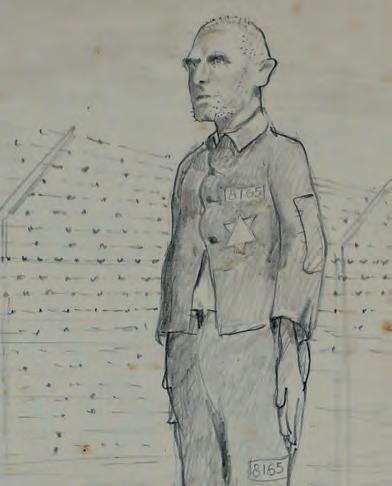
Sarah Saaroni, one of our beloved Jewish Holocaust Centre survivor guides, spent the war as a teenager with a false identity as a Polish Christian. She constantly and narrowly eluded betrayal and its fatal consequences, but lost both her parents and most of her family. Many of Saaroni’s sculptures
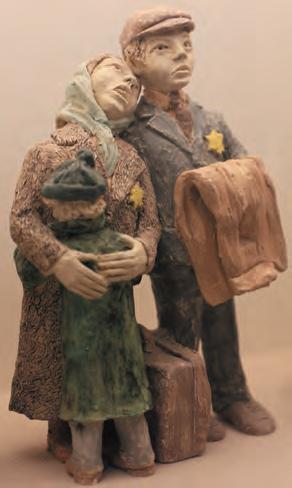
in the JHC museum that depict scenes from camps integrate stylised abstraction with self-portraiture, showing an essence of identification with each victim: It could have been me, it could have been any of us. In this immersive manner, Saaroni overcomes the depersonalisation that may be found in some Holocaust artworks. Her work is simultaneously fragile and powerful, and entirely humanist.
A few small but skillful and captivating pencil drawings by a teenaged Esther Werblud in 1945 capture her impressions after liberation. One image shows a jubilant young woman, surrounded by music notes as she dances on the paper. The joyfulness of the woman is palpable, but personally and historically, the line drawing is shaded with so much sorrow.
Art by survivors often confronts us with horrifying images of death, loss and torture, but there is also an inherent resistance that lived within each soul. Often when words and expressions are limited – either through language or personal suppression – images can contain and convey the unspeakable. These artworks, together with many other examples that can be viewed in the museum, as well as in other spaces in the JHC, contribute significant visual testimony that enhances not just our understanding of historical events, but the enduring emotional impact of trauma. The most powerful art has always transcended the strictures of its contemporary aesthetic rules to create ones more suitable for expression, and this is evident in our works that continue to bear witness and narrate personal and collective stories.

JHC Centre News 11
Dr Anna Hirsh, JHC Archivist, is an art historian.
1 Chaim Sztajer, Treblinka Model, photograph by Wolfgang Sievers, mid-1980s
2 Sarah Saaroni, Deportation II, 1984
3 Hermann Baum, Untitled (self-portrait, detail), c1940s
2 3 4
4 Esther Werblud, Untitled, pencil on paper, 1945
Saba Feniger: abandoned at sea
Irris Makler
Saba Feniger was born in Poland in 1924, the youngest of three sisters. Saba’s mother died when she was 11. When the Nazis established the Lodz Ghetto, Saba and her father, two aunts and elder sister were forced to live in a single room. Her father died in the ghetto. At the age of 20, Saba chose to go to the ‘collection point’ for ‘resettlement’ rather than hide when the ghetto was being liquidated. She and her two aunts, Gucia and Pola, were transported in cattle trucks to Auschwitz, where Gucia was gassed. Saba and her beloved aunt Pola were then sent to Stutthof, where Pola died. Saba’s eldest sister, Hela, her husband and baby were murdered by the Einsatzgruppen and only her middle sister, Eda, survived. Saba was liberated in 1945 and came to Australia to begin a new life.
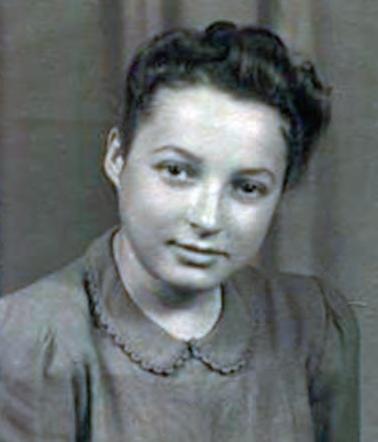
Saba was the first curator of the Jewish Holocaust Centre museum. Mother, grandmother and great grandmother, she is the author of a memoir, Short Stories, Long Memories, poetry and a novel, Rebirth 1945
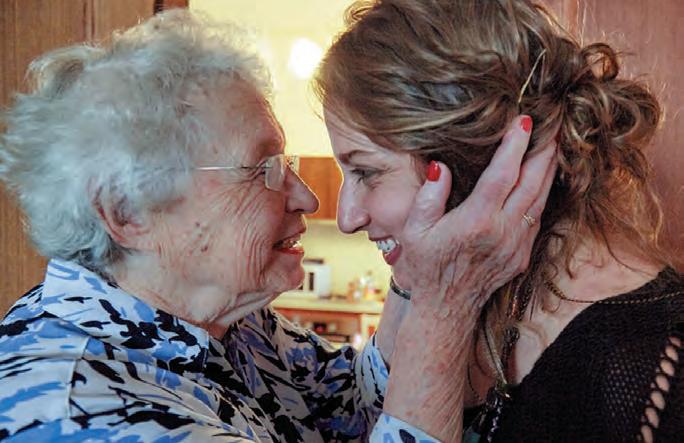
This is an account of Saba’s liberation in May 1945.
In April 1945, Stutthoff concentration camp was surrounded by Russian troops on three sides. In front was the Baltic Sea. To avoid capture, the Nazis put their prisoners on barges and used trawlers to tow them out to sea.
On Saba’s barge there were hundreds of men and women, perhaps as many as 1,000, sailing west in the direction of Germany, with little food or water.
So we were there for a week, according to the official papers, and lots of people were drinking salt water and the food, of course there was none, so people were dying. Because we came from a concentration camp and how well were we in a camp?
And then on 2 May 1945 it became clear that the Germans had left us. They went off in the trawler, and left us there on
the barge, hundreds of people without any means of reaching land!
Saba says they could have easily died there. They were saved by their own ingenuity. Among the prisoners were Norwegians who were captured soldiers. They gathered all the blankets aboard and stretched them out to form a makeshift sail.
They were very clever. They knew that the prevailing wind might bring us to shore, and they were right. They brought us to what turned out to be Germany, the German port city of Neustadt-Holstein. In the meantime we also saw some ships in the distance on fire, so we thought, okay well this is it, Hitler is dead, we’re free!
But there were German soldiers on the shore waiting for them. So we got off the barge, whoever could. Who couldn’t, and stayed, they went up and shot them all. The soldiers stood there with the machine-guns and ratatatat…
That was not the end.
While we stood there on the beach we saw people, prisoners, coming with German soldiers in front and behind, and they pushed them, they forced the people into the water near the barge and machine-gunned them too.
Saba says the water at Lubeck Bay was red with the blood of this group of up to 40 prisoners shot near the barge.
In May 1945? As the war was ending?
Yes. They machine-gunned them all in front of our eyes. Why didn’t they shoot you as well?
I don’t know why
German soldiers marched prisoners, including Saba, up to an open piece of ground, like a sports oval, at a German naval base. So we sat there on the sports oval for quite some time. No food, no water. And then German soldiers told us to get up and go back to the shore.
They reached the shore as an air raid was taking place. The British Air Force was bombing Lubeck Bay. ‘Saba, hide!’ a friend yelled, looking up at the British war planes. But Saba had seen so much death she had become fatalistic.
I said, if it hits me, it hits me, and I didn’t hide.
They survived, but another tragedy occurred in front of their
JHC Centre News 12
1 2
eyes. The RAF was targeting what it thought were boats of escaping Germans, but turned out to be barges carrying other concentration camp prisoners.
Some 7,300 prisoners died, killed by mistake by British bombers on one of the last days of the war. And Saba was there, a witness to it all.
After the air raid, Saba and her friends returned to the only place they knew, the sports oval. As they walked up, they saw armoured jeeps driving towards them. But something was different. The soldiers were not wearing German helmets.
So in English I asked them were they Americans. And they said, ‘No, we’re British!’
This is an extract from Irris Makler’s blog Food is Love: http://www.foodislove.co/blog-1 which features Holocaust survivors’ stories and recipes. Apart from Saba Feniger’s story and her delicious cheesecake recipe, you will find stories and recipes from Annetta Able and Stephanie Heller, and Sarah Saaroni, as well as other survivors.
1 Saba Feniger, June 1945
2 Saba Feniger and her granddaughter Karen Photographer: David Mane, Food is Love Blog
The IHRA meets in Hungary
Pauline Rockman OAM and Sue Hampel OAM
In June 2015, Australia was granted observer status on the International Holocaust Remembrance Alliance (IHRA). The Australian government chose eight specialists in specific fields to represent Australia on this important professional international body for a term of two years. The Victorian representatives included the co-presidents of the Jewish Holocaust Centre, Sue Hampel and Pauline Rockman, Deakin University academics Donna-Lee Frieze and Steve Cooke, Noah Shenker from Monash University, and Andre Oboler from the Online Hate Prevention Institute, Australia.
IHRA began in 1998 as the ‘Task Force for International Cooperation on Holocaust Education, Remembrance and Research’. The outcome of the first meeting was the ‘Declaration of the Stockholm International Forum on the Holocaust’, which became the mission statement of the IHRA.
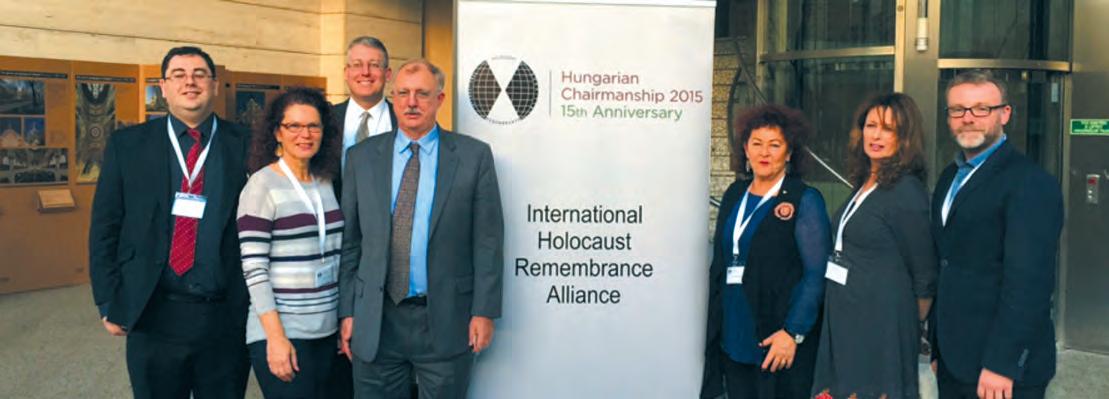
Plenary meetings were held in Debrecen, Hungary from 2–5 November 2015. Debrecen is the third largest city in Hungary and had been an important centre for Jewish life before the Second World War. Over four days, around 200 policy makers and experts from around the world representing 31 member countries, ten observer countries and seven international partner organisations, met to discuss the Holocaust as a contemporary political issue.
A focus of the plenary sessions was the issue of refugees and its relevance for the IHRA. Professor Yehuda Bauer, Honorary Chairman, prepared a paper on the ‘Migration Crisis’ which
generated heated discussion among IHRA delegates. Professor Bauer noted that the current refugee situation is very different from the persecution of Jews and other victims before, during and after the Holocaust. He cautioned against using historical analogies, although there are some parallels between the treatment of refugees then and now. Bauer argued that the wider political world should do everything in its power to act to alleviate the suffering of victims and, at the same time, seek a sustainable and coordinated international solution to the crises which have led so many refugees to seek asylum in Europe.
The Plenary meetings were followed by a conference on ‘The Holocaust in Public Discourse. Use and Abuse’ in Budapest on 6 November.
At government level, Australia was represented by Mr Kevin Playford, Director of Human Rights and Indigenous Issues, and Mr David Stuart, Australia’s Ambassador to Hungary.
The Holocaust has a universal meaning for all countries. We are pleased that Australia has become an IHRA observer country and we look forward to the prospect of keeping the memory and education of the Holocaust firmly on the Australian and global agenda.
The next plenary meetings will be held in Bucharest in May 2016.
JHC Centre News 13
Photo: (l-r) Andre Oboler, Sue Hampel OAM, Kevin Playford, David Stuart, Pauline Rockman OAM, Dr Donna-Lee Frieze and Dr Steve Cooke.
The Holocaust, culture and complicity
Theodore Wiesengrund Adorno was born in Frankfurt in 1903 and died in 1969. His long-term colleague and close friend, Max Horkheimer (cited in Clausen 2008, p 367), called him a ‘genius’ as he had ‘mastered…aesthetics…musicology, sociology, psychology, and intellectual history…to an almost unparalleled degree.’ Like so many others, Adorno had fled the Nazis in the early 1930s, but he returned soon after the Second World War and was then prominently involved in university and public life, particularly in relation to debates about collective responsibility. As Scholar-in-Residence here at the Jewish Holocaust Centre (JHC), I am testing Adorno’s ideas about collective responsibility against the survivors’ testimonies.
You might ask why a social work lecturer is researching the Holocaust. Social work at Victoria University is taught in the anti-oppressive tradition, which emphasises the critique of, and actions to change, structures of domination. Our tradition is a deeply theorised one, and, like many philosophers, sociologists and psychologists, traces its roots to the Institute for Social Research at Frankfurt University, Germany, which was founded in the early 1930s. Theodore Adorno was one of its founding members.

Why draw on Adorno’s works?
Adorno was particularly interested in how ordinary, everyday ways of thinking can make people complicit, often unintentionally,
in systemic harm: in particular, how such ordinary aspects of culture enabled compassion to be suppressed. He saw one aspect of this in the way in which popular culture failed to give adequate attention to suffering. People were too quick to focus on ‘higher things’. For Adorno (1967, p23-24), this avoidance, ‘that people refuse to let [suffering] draw near and indeed even rebuke anyone who merely speaks of it’, risked the repetition of the Holocaust. He insisted that we had to face the experience of suffering, and not turn our backs to it. We were obliged to make ‘suffering eloquent’. Indeed, he said that the ‘need to lend a voice to suffering is a condition of all truth’ (1973, p18).
One of the founding tenets of the JHC, and all those engaged in remembrance and research in relation to the Holocaust, is the need to give witness. At the heart of that commitment is a consciousness that the risk of repetition remains with us. For that reason alone, I believe Adorno’s works are worth investigating.
Compassion and Complicity Then
Adorno has a lot to say about Western culture. Like the betterknown Hannah Arendt, he held that the Holocaust was not something foreign to Western culture, but a product of it: something so ordinary, so commonplace, as to be almost invisible – something ‘banal’ (to borrow from Arendt’s famous claim). One could give the Holocaust an exclusively Nazi stamp. One could treat it as part of a distant aberration, an outbreak of barbarism and animality, and think of the cure as suppressing that animality, but the difficulty with this is that, in many ways, this has been the essence of the West’s idea of civilisation for a long time – the rule of reason over animality (over our emotions or our instincts). This is precisely what Adorno challenged –this confidence that the rule of reason could secure us against barbarity, and that the Holocaust followed from a lapse in reason. Adorno challenged this fundamental conception of ourselves and a good society – and the fundamental, everyday, ‘banal’, confidence in reason. Rather than see the Holocaust as following a lack of civilisation, he saw the Holocaust as a product of it.
JHC Centre News 14
– then and now
John G Fox
Adorno, and many others who draw on the same tradition of philosophical thought, see Western culture built on the domination of our bodies, and of the balance of the physical or material world. Western culture then locates the essence of – the best of – our humanity in something other than our bodies and the material world: a thing we have often called reason. To be our best individually, and as a society, the ideal was for reason to dominate all else. Today we might speak of ‘mind over matter’. It made self-discipline an ethical ideal. The best of our humanity was to be secured through discipline and control: ‘cool’, or to use Adorno’s (2006, p 155) term, ‘cold’, reason was to preside. However, Adorno suggested that this blunt suppression of emotions also suppressed the capacity for compassion, and enabled ordinary people in Nazi Germany to ignore the clear evidence that some wholesale horror was unfolding in their midst.
It is the role of ‘ordinary’ people and their complicity in systemic injustice in which I am particularly interested. Tens, if not hundreds of thousands of people effectively cooperated in the Holocaust, if only through their deliberate inaction. By ‘deliberate inaction’ I mean that these people were aware of the work towards exclusion and extermination and chose not to act. I also mean that many people had sufficient clues or indications that a massive campaign of deliberate harm was underway: those people –at least - were on the threshold of certain knowledge of the Holocaust, and refused to take the steps that would have given them that knowledge.
I am not suggesting that all of these people’s inaction was always blameworthy, given the threat of violence, the pressures towards group conformity, and other influences. However, I worry that a focus on these influences lets the rest of the world off too easily. That is why I believe Adorno’s efforts to examine what is seen as ordinary or banal – even today – deserves our attention. It is just too easy to say the Holocaust was an aberration, and that preserving our way of life is the best defence against its repetition.
One key feature of the West’s way of life is its definition of being human in a way that privileges the mind over the body. Acting in accordance with our best natures has been seen as freeing the mind from the body. Adorno was concerned that this belief – that to be human was to discipline our bodies – made other kinds of violence, often in subtle forms, acceptable. He considered that our bodies, our emotions, even our instincts, were much more central to the best of our humanity – and that the repression or disciplining of our bodies had played a vital part in enabling the Holocaust.
In the light of the Holocaust, and the failure of culture to safeguard against barbarism, Adorno thought that the body – in particular our bodily reaction, our ‘gut reaction’, to others’ suffering – was the last reliable foundation of morality. He (2001, p 115-117) argued that ‘the true basis of morality is to be found in bodily feeling’ – that ‘morality…lives on in openly materialist motifs’.
I believe we better approach his point if we read ‘motif’ as ‘motive’, in the sense that a motive is something that moves or motivates us to act, and consider what morality is in its most basic sense – the responsible or just treatment of others. In that most basic sense then, morality involves the recognition that others are owed something, and that obligation in some unavoidable, undeniable way attaches to us. Adorno saw the foundations for that recognition and attachment in our shared experience of bodily pain. For Adorno, to witness another’s pain prompted an involuntary empathy – that wince or heartache we all know when witnessing another getting hurt. It provided
a motive to care about the impact on the other person – and a connection, a sense of common concern, to respond to it.
I am sure you are familiar with the many instances in which people did act. It seems a rare survivor’s testimony that does not speak of at least one such instance. People – often strangers – spontaneously stepped up to save others. You celebrate and acknowledge those acts. Yet part of the reason for that recognition is because those acts were exceptional, and infrequent. We tend to locate that potential to intervene in individuals as a question of character. I believe that is only part of the story. You will also be perfectly aware that, while the ‘gut’ reaction to witnessing suffering can prompt one to act, it does not ensure that one does so. It can be, and often is, suppressed. The Holocaust is itself evidence of the extent and efficacy of just that. One reason for my research is to consider the extent that Western culture enables or restrains that spontaneity – and what we might do to increase it. That may be idealistic, but then you have celebrated those instances too: the work of the Danes, for example, and of the Muslim villagers who – collectively – helped save many Jewish people.
Compassion and Complicity Now
I believe the need to promote compassion is increasingly important these days. The place we give to compassion – and the extent to which we let ourselves be guided by it – features in debates that are central to our society, and its social policies, both locally and internationally. For years now, elections in this country have turned on how ‘tough’ our politicians can be with those who come here by boat seeking refuge. For an even longer period, although with less prominence, elections have featured calls to be ‘tough’ on those dependent on welfare payments. It has seemed that the public has too readily blamed these people for their predicament, and too easily quashed their sense of compassion. And yet these last few months have shown a very different sentiment, and not only here, but around the world. The death of a young Syrian boy – the witnessing of his unearned suffering – prompted compassion and action on a worldwide basis. I am sure many of you saw the television broadcasts of Syrian refugees being welcomed in Germany. There was something beautiful in that welcome. It was also something exceptional, given that other countries lacked a similar response.
Compassion is central to your business. Seeing, witnessing and responding to suffering – enabling it to be eloquent enough to move people – sits at the core of your endeavour. In these times, looking to the near future, I think we may need much more of that.
References
Adorno, TW 1967, ‘Education after Auschwitz’, in Tiedemann, R (Ed) 2003, Can one live after Auschwitz? A philosophical reader, Standford University Press, Stanford
Adorno, TW 1973, Negative dialectics, Routledge, London
Adorno, TW 2001, Metaphysics: Concepts and problems, Polity, Cambridge
Adorno, TW 2006, History and freedom, Polity, Malden
Clausen, D 2008, Theodor W. Adorno: one last genius, Belkaap Press, Cambridge
Dr John G Fox, Lecturer in Social Work at Victoria University, is Scholar-in-Residence at the Jewish Holocaust Centre. This is an edited version of a lecture he gave at the Centre in December 2015.
JHC Centre News 15
Photo: John G Fox
Reflections on the ‘Jewish Refugees and Shanghai’ exhibition
Reuben Zylberszpic
In September and October 2015 the Jewish Holocaust Centre (JHC) hosted ‘Jewish Refugees and Shanghai’, a travelling exhibition created by the Shanghai Jewish Refugees Museum, featuring photos and text in English and Chinese, telling the story of the Jews who found a haven from Nazi persecution in an unlikely place: the city of Shanghai.
The exhibition informed visitors of the circumstances leading to their escape from Europe and the challenges of life in Shanghai. It featured numerous personal stories, including several stories of Melbourne Jews who lived in Shanghai during the Second World War.
The JHC enhanced the exhibition with a display of artefacts from its collection, as well as items loaned from members of the community. These reflected and documented the desperate attempts of Jews in Nazi Europe to find countries of refuge, and the extraordinary experience of living in China during the war.
The exhibition attracted a diverse cross-section of the community, including ‘Shanghailanders’ and their families who came out in force to view the exhibition, as well as members of the Jewish and Chinese communities and the general public. The launch of the exhibition saw over 250 people squeeze into our main auditorium (with the overflow viewing the proceedings via video-link from the JHC’s downstairs auditorium). This reflected the community’s strong interest in this unique story of Jews fleeing Nazi-occupied Europe.
It was heartening to see many Shanghailanders attend with their extended families, including children, grandchildren and greatgrandchildren, sharing their stories of survival.
The exhibition’s public program, which ran as an adjunct to the exhibition, included a screening of the film Shanghai Ghetto, a feature-length documentary with interviews of survivors, historians and historical and modern footage shot in Shanghai, a lecture by Professor Andrew Jakubowicz, and a presentation
of photos taken in Shanghai by Horst Eisfelder. Professor Jakubowicz delivered an insightful lecture titled ‘Jewish Refugees and Shanghai: reflections on seventy years after liberation’, while Horst Eisfelder spoke about his life as a teenager in Shanghai, illustrating his presentation with the wonderful photographs he took to record his life in exile.
While this exhibition shone a light on a little-known story of the Holocaust, it resonated with world events today. This was poignantly highlighted in the JHC Curator Jayne Josem’s speech at the launch in which she quoted American journalist, Dorothy Thompson, who in 1938 wrote: ‘It is a fantastic commentary on the inhumanity of our times that for thousands and thousands of people a piece of paper with a stamp on it is the difference between life and death.’ Jayne continued:
This quote cuts to the heart of what the travelling exhibition ‘Jewish Refugees and Shanghai’ is about. Yet I wonder, is it just me or did that make any of you think about what is going on in Europe right now, with thousands of Syrian refugees clamouring to find a safe haven for themselves and for their families? I do not know about you, but the news this past week has made me think a lot about Jews in Europe in the period 1938 to 1939, about the Evian Conference, and about the St Louis ‘voyage of the damned’…
Jayne’s words highlighted the importance of the educational work of the JHC in presenting such exhibitions, in that by focusing on historical events, we also remain relevant to current issues.
We thank our supporters for their generosity which allowed us to present this important exhibition:
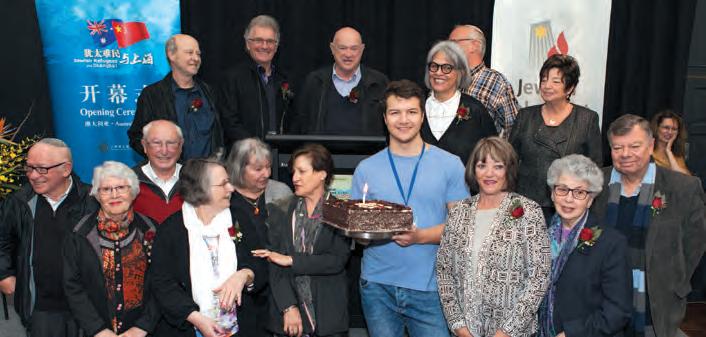
Patrons:
Anita and Danny Selzer
Elton and Fineberg Family
Ron and Sarah Tatarka and family together with Scott Winton Insurance Brokers
Supporters:
Eva Light
Glen Eira City Council
Friends:
Gary Peer Chinese Museum, Melbourne
Shanghai Jewish Refugees Museum
Above:
1 ‘Shanghailanders’ with Deniz Sezer
2 (l-r) Dr Evie Katz and Julia Gao
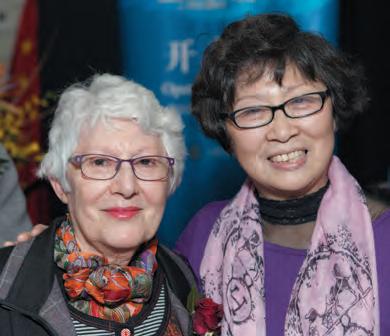
JHC Centre News 16
1 2
Remembering life in Shanghai
Shanghai was a major trading centre long before the Second World War and had a well-established Jewish community, making it a natural destination for European Jews fleeing from persecution. While Jews were denied entrance to other countries, Shanghai was an ‘Open City’, as no entry visas, passports and financial restrictions were required. The story of Shanghai providing a haven for approximately 23,000 Jewish refugees from Germany, Austria, Czechoslovakia and Poland, however, has not received the prominence it deserves and can easily be called ‘The Lost Chapter In History’.
For Jews coming from European cities like Berlin, Vienna, Prague and Warsaw, life in Shanghai was tough, but bearable – unlike that of our brothers and sisters in Europe who had so much to endure. Thank God most of us managed to survive, helped by the solidarity of the Chinese people who stood by us during those dark days, as they shared our hardship with compassion and friendship, forming a common bond.
Arriving at the Bund, the waterfront of Shanghai, we saw massive destruction and damaged houses as we were driven through the streets to our accommodation compound. This was the result of a bitter war with Japan that had begun in 1937. There were homeless people and mutilated bodies lying in the streets, and we new arrivals began to wonder whether coming to this place was the right decision.
However, history has taught us that Jews have always been enterprising, so the new arrivals were creative and resourceful, and despite the squalid conditions, busied themselves opening restaurants, cafés, bakeries, barber shops, shoe and clothing repair shops, groceries, tobacconists, dental clinics and even currency dealing depots. Two Jewish schools were established by wealthy Jewish families from Bagdad, the Kadoories and Sassoons. They had made their fortune in banking, opium, real estate, tea and cotton, and generously spread their wealth building hospitals, homes for aged people, hotels and sporting arenas, providing many employment opportunities as well as much-needed services.
My wife, Eva, and I met in Shanghai in 1943, when she was 11
years old and I was 13. This was the beginning of a life-long love story which lasted for 70 happy years, until Eva passed away in 2014. Eva and I returned to Shanghai on a sentimental journey to visit our wartime home which we left in 1946. We were keen to revisit our living quarters, school buildings and playgrounds, but most importantly, our Ohel Moshe Synagogue where my father conducted religious services for seven years. To our surprise we discovered that the synagogue building was now the home of the Shanghai Jewish Museum, the government having funded the renovation to create the museum of today.
Apart from the Kadoorie and Sassoon families, some of the prominent personalities who lived in Shanghai during the Second World War include Michael Blumenthal, who became the Secretary of the Treasury under President Carter; Harry Triguboff, the Sydney real estate giant; Eli Wacks, a leading fashion designer in New York; Sam Moshinsky, an author and historian; and the late Isador Magid, an eminent Jewish communal leader.
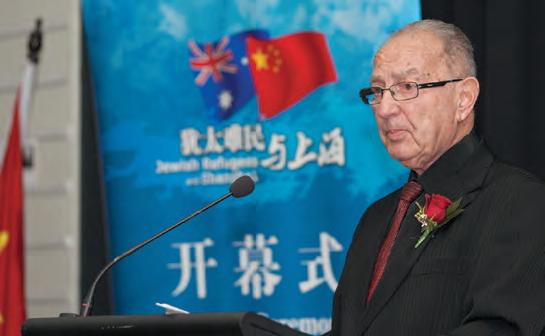
Last but not least, the amazing Sempo Sugihara, the Japanese Consul in Kovno, Lithuania, helped Jews escaping the Holocaust by issuing life-saving visas to allow them to leave Europe. As a result of his daring and compassion, rabbis and students from the Lubovitcher, Lubliner and Mirer yeshivas, who were transiting in Shanghai to Japan and South America, used their time to keep the flames of Jewish traditions and ritual alive. With their vast knowledge of Torah and religious heritage, they taught Jewish youngsters, and I was one of the lucky ‘recipients’ of their mission. They prepared me for my barmitzvah in 1943, teaching me to recite my Maftir and Haftarah on my special day. Sugihara, for his heroic deed of issuing those exit visas, was honoured as a Righteous Among the Nations at Yad Vashem, Jerusalem.
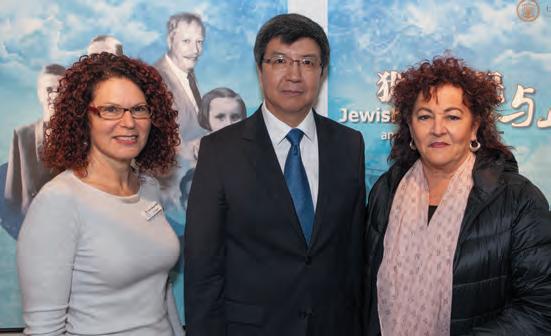
Life for the Jewish refugees was about to change in 1943, as Hitler became aware of the 23,000 Jews who had escaped his murderous hands. He sent a high-ranking Gestapo officer to Shanghai to induce the Japanese authorities to implement a ‘Final Solution’, as he was doing in Europe. The Japanese authorities defied this request, but agreed instead to relocate Jewish refugees into Hongkew, a poor area of Shanghai, which became known as the ‘Shanghai Ghetto’, an area of only one square mile, with very poor living conditions.
This is an extract from an address delivered by Fred Antman at the opening of the ‘Jewish Refugees and Shanghai’ exhibition held at the Jewish Holocaust Centre.
Above:
1 (l-r) Sue Hampel OAM, Song Yumin, Consul-General of the People’s Republic of China in Melbourne and Pauline Rockman OAM
2 Fred Antman
JHC Centre News 17
1 2
Fred Antman
L’dor va’dor: Holocaust memorial museums and the intergenerational transmission of memory
Avril Alba
A second century midrash refers to an historical moment similar to our own, the time at which the living memory of the destruction of the Second Temple was beginning to be interpreted by the generations that came after. It reads:
Rabbi used to interpret the verse ‘the Lord laid waste without pity’ in 24 ways. Rabbi Yohanan could interpret it in 60. Could it be that Rabbi Yohanan was greater than Rabbi!? Rather, because Rabbi was closer in time to the destruction of the Temple he would remember as he interpreted and stop to weep and console himself. He would begin again only to weep, console himself, and halt. Rabbi Yohanan, because he was not close in time to the destruction of the Temple, was able to continue to interpret without pause.
(Lamentations Rabbah)
Our midrashist is faced with a seemingly unsolvable contradiction: How could it be that the one closest to the destruction—the great figure of ‘Rabbi’, Judah HaNasi, the redactor of the Mishnah (Oral Law)—is only able to offer 24 interpretations of the destruction, while Rabbi Yohanan, who lived after the Temple was destroyed, was able to offer 60? Surely, such a situation was counterintuitive. A closer reading reveals a deeper dynamic at work. The experience of history (to stop to weep) is both the burden and struggle of the generation of witness, the generation of the survivors; the work of memory (to interpret without pause) is the task of the generations that
come after, those who ‘do not stop to weep’. ‘To weep’ is to recall a traumatic history; ‘to interpret’ is to make sense of that history, to find meaning and to transmit that meaning to generations to come. But what will the content of this meaning be? This is perhaps ‘the’ question for the Australian Jewish community, the community that received the most Holocaust survivors per capita outside Israel, as it seeks to transmit this memory L’dor va’dor. And how will perhaps their most influential institutions seek to meet this challenge?
From their inception, Australian Holocaust museums have stood in contrast to their international counterparts as privately founded, funded and survivor-driven (Berman 2001). However, with the passing of the survivor generation, these museums will soon largely be comprised of children of Holocaust survivors, the ‘second generation’. This generation has brought its own understandings of Holocaust history and memory to bear on institutional priorities and is harnessing these understandings to enact substantial change—often in line with international trends rather than personal, communal imperatives. In so doing they are, I contend, grappling with where and how their personal, familial and intra-communal memories (postmemory) intersect with more public expressions of Holocaust memory (nonwitness memory).

The influence of intergenerational change on the shape of Holocaust memory is increasingly apparent. Indeed, one of the most salient features of the many imperatives to ‘remember’ the Holocaust is the call for intergenerational mechanisms to perpetuate the stories and legacy of the victims. So strongly felt is this imperative within the now-vast corpus of Holocaust ‘memory forms’—forms that encompass but are not limited to cultural, religious, psychological, artistic and educational mediums—that intergenerational transmission has emerged as a dominant feature of both lay initiatives and scholarly debate.
Within this corpus, Marianne Hirsch’s theory of ‘postmemory’ has dominated recent discussions concerning the dynamics of intergenerational transmission of Holocaust memory. Hirsch defines postmemory as ‘the relationship of the second generation to powerful, often traumatic, experiences that preceded their births but that were nevertheless transmitted to them so deeply so as to seem memories in their own right (Hirsch 2001: 103).’ She notes that her theory of postmemory contains an inherent contradiction or paradox. On the one hand, she asserts that members of the second generation feel the experience of their parents so deeply they assume an immediate, affective knowledge of the events that have been transmitted. Yet, simultaneously, they are aware that they were
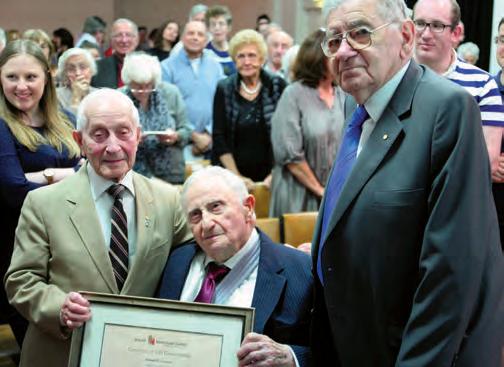
JHC Centre News 18
1 2
not privy to these events and will remain forever unable to truly penetrate the stories transmitted to them.
These terms reveal a number of controversial assumptions: that descendants of survivors (of victims as well as of perpetrators) of massive traumatic events connect so deeply to the previous generation’s remembrances of the past that they need to call that connection memory and thus that, in certain extreme circumstances, memory can be transmitted to those who were not actually there to live an event. At the same time—so it is assumed—this received memory is distinct from the recall of contemporary witnesses and participants. (Hirsch 2001: 105-106, emphasis in original)
Challenging Hirsch’s self-confessed paradox, Gary Wiessman acknowledges that while children of Holocaust survivors will reach an understanding of ‘what the Holocaust was’ from a different subject position to those ‘non-witnesses’, that is, those with no familial connection to the Holocaust, this knowledge is not because survivors’ children experience the Holocaust and ‘non-witnesses’ do not. Rather, children of survivors experience their parents’ recollections, thoughts, and feelings about the Holocaust, their parents’ ‘memory’. Weissman concludes that while the ‘second generation will never know what their survivor parents knew in their bones, what the second generation knows better than anyone else is the first generation (Weissman 2004: 18).’ Therefore, while the postmemory of children of survivors may be more visceral than that of others it is still a secondary experience, what Weissman labels an experience of Holocaust ‘representation’ (Ibid: 20), except that the representation in question is familial and hence intensely personal and often enmeshed within the second generation’s very sense of self.
Hirsch seeks to connect the intensely personal familial experience of postmemory with the concerns of Holocaust memory and remembrance more generally:
At stake is not only a personal/familial/generational sense of ownership and protectiveness but also an evolving theoretical discussion about the workings of trauma, memory, and intergenerational acts of transfer ... More urgently and passionately, those of us working on memory and transmission have argued over the ethics … of remembrance in the aftermath of catastrophe. How, in our present, do we regard and recall what Susan Sontag (2003) has so powerfully described as the ‘pain of others?’ What do we owe the victims? How can we best carry their stories forward without appropriating them, without unduly calling attention to ourselves, and without, in turn, having our own stories displaced by them? … Can the memory of genocide be transformed into action and resistance? (Hirsch 2001: 104)
The debate concerning the nature and efficacy of intergenerational transmission is currently mired within these murky waters of ‘appropriation’. Both Hirsch and Weissman’s work illustrates that a primary concern of the second (and now third) generations of both children of survivors and ‘nonwitnesses’ is to ‘experience’ rather than ‘learn about’ the Holocaust. As Hirsch notes, ‘postmemory’s connection to the past is thus not actually mediated by recall but by imaginative investment, projection, and creation (Ibid: 106-07)’.
As Australian Holocaust memory evolves, the increasing influence of the second and third generations ensures that their interpretations of survivor memory will remain the cornerstone in any discussion as to the ‘shape’ of that memory, at least for the foreseeable future. At the same time, it is increasingly evident that the second generation, like the first, does not speak with one voice and is unlikely ever to do so. Rather, what this
historical consideration of the institutional and intergenerational process of the transmission of memory brings to light is that the intersection between Hirsch’s largely private notions of ‘postmemory’ and Weissman’s more public, ‘non-witness’ expressions of intergenerational response are deeply interlinked. The individual and private memories of the second generation will necessarily influence and shape the public expression of Holocaust memory in Australia but they cannot, and will not, dictate its final form, nor its public reception. Rather, the element of compromise that characterises communal endeavours, combined with the demands of public space, will ultimately determine the shape of Australian Holocaust memory.
And so, in conclusion, we return to Hirsch’s poignant and pressing question: ‘Can the memory of genocide be transformed into action and resistance? (Hirsch 2008: 104)’1 If the experiences of the Australian Holocaust museums are understood as ‘concrete’ attempts to answer this dilemma, then based on a consideration of past and contemporary debates, our conclusions must be tentative but also hopeful. What must be recognised is that the private memories of the second and third generations are varied, often contradictory and always in debate. Their memories reflect their diverse interpretations of both a private and a communal history; producing interpretations that may, or may not, be deemed in harmony with a changing Australian public landscape. The challenge, therefore, facing the current museum leadership in both cities is to engage these intensely personal and diverse intergenerational memories, while forging and maintaining a commitment to broader communal and institutional priorities. If Australia’s Holocaust museums can maintain the centrality of the Australian community’s distinct, yet diverse, experience of Holocaust history and memory while engaging with the broader concerns—if it can hold the particular and the universal in tension while refusing to relinquish either—then the intergenerational and institutional transmission of Holocaust memory may indeed be realised. It is with these complexities and challenges in mind that just as our midrashist wrote two millennia ago, our respective institutions can and must continue to ‘interpret without pause’.
This is an edited version of the Betty and Shmuel Rosenkranz Oration Dr Avril Alba delivered at the Jewish Holocaust Centre in November 2016. Dr Avril Alba is Lecturer in Holocaust Studies and Jewish Civilisation at the University of Sydney. The full text appears in Alba, A (2014). ‘Set in stone? The intergenerational and institutional transmission of Holocaust memory” in Nigel Eltringham, Pam Maclean (Eds), Remembering Genocide, (pp. 92-111). Abingdon, Oxon: Routledge. This volume also includes contributions from Pam Maclean and Donna Lee Frieze
Hirsch, M. (1997) Family Frames: Photography, Narrative and Postmemory, Cambridge: Harvard University Press.
________ (2001) ‘Surviving Images: Holocaust Photographs and the work of Postmemory’ Yale Journal of Criticism 14,1: 5-37.
________ (2008) ‘The Generation of Postmemory’ Poetics Today 29:103-128.
Weissman G, (2004) Fantasies of Witnessing: Postwar Efforts to Experience the Holocaust, Ithaca: Cornell University Press.
JHC Centre News 19
1 (l-r) Abram Goldberg OAM, Shmuel Rosenkranz and Willy Lermer OAM
2 (l-r) Viv Parry, Jayne Josem, Dr Avril Alba, Warren Fineberg and Mary Slade
The Interior of Our Memories is launched at JHC
Nina Bassat AM
Centre; noted the many discussions on how remembrance and commemoration should best be addressed; raised the vexed question of the specificity of the Shoah as against its universality; and set out the practical aspects of what the JHC does and the people who have been and are involved at the Centre.
This is an ambitious project, thoroughly researched and clearly written in a scholarly manner. The book takes us back to the time when inmates began documenting the Shoah in the Lodz ghetto, and when a young man in Auschwitz in 1944 realised that he was mandated to testify about what had taken place.
This was the genesis of the JHC, so that by the time the first meeting to discuss establishing a centre took place in 1983, the groundwork had been laid, both with events during the Shoah, and with the discussions, commemorations and exhibitions that had already taken place.
The significant number of Holocaust survivors who had made their home in Melbourne had a clear understanding that to testify, to remember, to commemorate, were imperatives for all those who had survived. They could do no less than that. And so in March 1984, on a hot afternoon, the JHC became one of the earliest Holocaust centres outside Israel.
 Written by Deakin University academics Steven Cooke
Written by Deakin University academics Steven Cooke
and Donna-Lee
Frieze, The
Interior of Our Memories analyses the development of the Jewish Holocaust Centre (JHC) within global Holocaust memorial activity, both during the genocide and in the decades which followed, when many survivors made new lives for themselves in Melbourne. The story begins, not in March 1984 when the JHC first opened its doors, but during the Holocaust, when survivors began gathering documents. The book provides a history of the Centre’s early days and examines its transformation from a collection of photos, documents and material objects into the modern, educationally focused organisation it is today. Generously funded by Phillip Maisel OAM, the book was launched at the JHC in October 2015 by Mrs Nina Bassat. This is an edited version of her address.
The history of the Jewish people is one of recurring duality. Over and over again there has been suffering and persecution, juxtaposed with survival and regeneration. These two themes are almost a constant in Jewish existence. The slavery in Egypt, the destruction of the Temples, expulsions, pogroms – these are all part of our collective memory and have shaped us over millennia. Survival despite all odds, and regeneration, are integral to our history.
This duality is also a part of the Shoah. There was the magnitude, the horror, the suffering brought about by the Shoah, followed by the triumph of survival and of regeneration, which has occurred throughout the Jewish world, not least in Melbourne.
The Interior of Our Memories documents a vital part of the regeneration of survivors, and of their determination to create a memorial and a testament to those who had not survived. And in so doing, the survivors not only created the Holocaust Centre, they also strengthened an entire community.
In writing this history, however, the authors have done much more than just tell the story of the Centre. They have also written about the context of the JHC in relation to other museums and centres; analysed the political background to the creation of the
A number of contradictory themes were apparent at the opening, particularly in framing the Shoah as unique, as a Jewish Holocaust, with no reference to other victims, and with a parallel focus on the ‘redemptive Zionist’ narrative. And although, for many, education was an important goal right from the beginning, this was not reflected at the opening.
Over time, there has been a strong focus on broadening the rationale for the Centre from memory and commemoration as the central activities, to developing an outstanding education program, to creating a serious testimonial recording program, and on developing an empathetic understanding of other genocides.
From the outset, a unique aspect of the JHC has been the centrality of survivors in every aspect of the operation of the Centre – administration, recording of testimonies, archiving, curating and, of course, guiding.
This great strength, however, has also created a significant challenge. As the survivors aged, the Centre had to give serious consideration about how it would operate in the future. This challenge has been faced with great sensitivity, resulting in a Centre which has transitioned from being survivor-guided and staffed to a combination of survivors, volunteers and professional staff. Members of the second and third generations have also taken up the challenge, as the book illustrates, and have now become an integral part of the JHC.
The authors have understood the imperatives behind the Centre’s establishment and have clearly and methodically set out not just the history of Melbourne’s JHC, but have also fleshed it out with the metahistory.
This book will enrich our understanding not only of the JHC, but of the dynamics, historical and present, of our community.
JHC Centre News 20
Photo: Nina Bassat AM
Farewell to the JHC
Anatie Livnat
How about the Jewish House of Celebration? So many celebrations! Only 50 more birthdays for me to catch up to some of you!
With so many celebrations we should also call the JHC the Jewish House of Cake!
We are the Jewish House of Creativity with so many diverse exhibitions, projects, panels, speakers, film and events.
The Jewish house of Collaboration, because not one of us here works alone.
The Jewish House of Commitment, and I do not just mean attendance on the days you are rostered to be here. I mean commitment to teaching the universal lessons and messages of the Holocaust.
Now, this you would all agree with me: the Jewish House of Complaints. Each one of us is a complaints department!
But that is because we are the Jewish House of Care. We all care so much about what happens here at the Centre.
Without a doubt we are the Jewish House of Compliments:
‘That’s a nice bracelet.’
‘That’s a beautiful colour on you.’
‘You smell so lovely! What aftershave are you wearing?’
‘You look so good today, so fresh!’
‘You spoke so well today.’
We are the Jewish House of Commemoration – my mother, my father, my brother, my sister, my grandparents, my people.
And you cannot be the Jewish House of Commemoration without being the Jewish House of Continuity and the Jewish House of Courage.
Anatie Livnat left the Jewish Holocaust Centre in December 2015 after six years as Education Officer. This is an edited version of her speech at the Centre’s end-of-year function.
I have been here at the Jewish Holocaust Centre (JHC) since 2009. In that time there have been many learning opportunities and within those learning opportunities, wonderful interactions, discussions, arguments, happy news, sad news, shock at my Diet Coke consumption, plenty of advice and, as a result, longlasting friendships have been made.
I have loved being a part of this Centre, a centre that promotes peace, promotes co-existence, promotes that the world is a mixed bag of nuts and that we may be different, but at the end of the day we are all nuts!
The acronym JHC stands for so much more than just the Jewish Holocaust Centre. It could and should also stand for the:
Jewish House of Connection, because we all feel it
Jewish House of Consideration
Jewish house of Conversation
Jewish House of Contemplation
Jewish House of Compassion
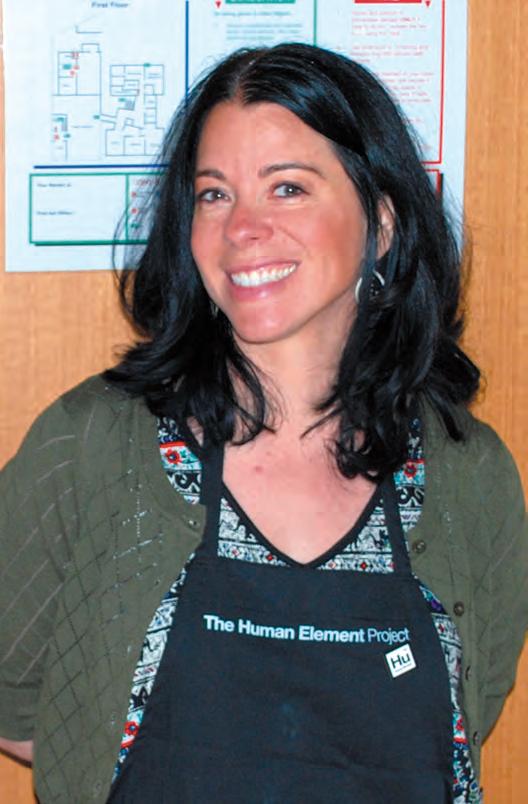
You know we do not often think about the courage it takes for the JHC simply to exist. Not just exist, but evolve and expand in a world that is quick to judge and believe in antisemitic fabrications. We stand tall, and not just because we are all so short [like me]! No, we stand tall and humbly share that we are Jewish and we are not what they say we are.
I find it also takes courage and strength not to be disheartened by the madness and hate outside these walls, and to keep trying, one student or one visitor at a time, simply because we know it must be done.
It has been an honour, a pleasure and a privilege working side by side with all of you. Thank you for having me. I shall definitely keep in touch. You are all very dear to me.
JHC Centre News 21
Photo: Anatie Livnat
From
The ‘New Australians’
Emer McCarthy
globe. Australia was a world away, both geographically and politically, from the atrocities of war-ravaged Europe. A laidback and seemingly carefree country which promoted itself as a beacon of opportunity and prosperity, Australia represented a new sort of freedom – freedom from persecution and fear which was commonplace before and during the war years in Europe. Australians had been urged by Prime Minister Curtin to ‘populate or perish’ in order to stop the perceived threat from Japan and to help increase the labour force in order to remain a country with a competitive economy.
Between 1945 and 1954, Australia accepted an estimated 17,000 Jews fleeing Europe, adding greatly to the Jewish populations of Melbourne and Sydney. Yet for many, Australia seemed a foreign and, at times, an unforgiving place.
For this article I interviewed Maria Lewit, Willy Lermer and Halina Zylberman, three inspiring survivors from the JHC, to learn about their experiences in moving to Melbourne. Although each has a very personal story to share, the common thread throughout is a love and sense of gratitude to Australia for giving them the opportunity to start a new life and the freedom to be their true selves without fear of persecution.
by Maria Lewit
The word ‘Smugglers’ may be applied as easily to those seeking asylum in Australia today as to the experiences of postWorld War Two refugees.
On my first day at the Jewish Holocaust Centre (JHC) I was given a copy of this poem by the author, Maria Lewit, one of the Centre’s survivor guides. After analysing it I decided that it would be worth using as the basis for my work at the Centre, comparing the refugee and migrant experience of the past to today.
They were the ‘New Australians’, refugees granted entry to Australia in the wake of the end of the Second World War. They brought with them new languages, foods and cultures that varied greatly from the Anglo-Celtic migrants who came earlier. Some came with family, others had lost everyone and everything they held dear. All were seeking a new life in the Great Southern Land.
The journey was long and arduous. Some came by boat, others by plane, to a mysterious land at the bottom of the
Maria Lewit OAM came to Australia in 1949 from Poland by way of France with her husband and young son Joe, after they received papers issued by the International Refugee Organisation (IRO). Australia became a signatory to the IRO in 1947 following a European state visit undertaken by Arthur Calwell, Australia’s first Minister for Immigration. Upon witnessing the desperation and trauma of survivors in displaced persons’ camps, Calwell realised the importance of opening up Australia’s borders to ‘New Australians’. This was a major step away from the Immigration Restriction Act, better known as the ‘White Australia Policy’, which had been in place since 1901.
Maria’s journey by boat took five weeks. Upon arrival, she lived on a poultry farm in Reservoir. She had first heard about Australia when her father pointed it out on a globe when she was a young girl in Lodz, Poland. Never could she have imagined that one day she would be living in Melbourne, especially after what she had lived through during the war years.
The Lewit family settled well into Australian life, yet at times Maria felt a sense of sadness for what she had left behind. ‘I would go outside and look at the sky, but the sky wasn’t the same,’ she said.
Over time, she learnt English and began to embrace her love for writing, a passion since she was a child. She has published two acclaimed novels, Come Spring and No Snow in December, which reflect upon both her experiences during the war and how she settled into life in Australia. Her poem, ‘Smugglers’, was based on her own experiences.
In December 1948, the Jewish Council to Combat Fascism and Anti-Semitism published the New Australians handbook to educate the population about the positive impact Jewish
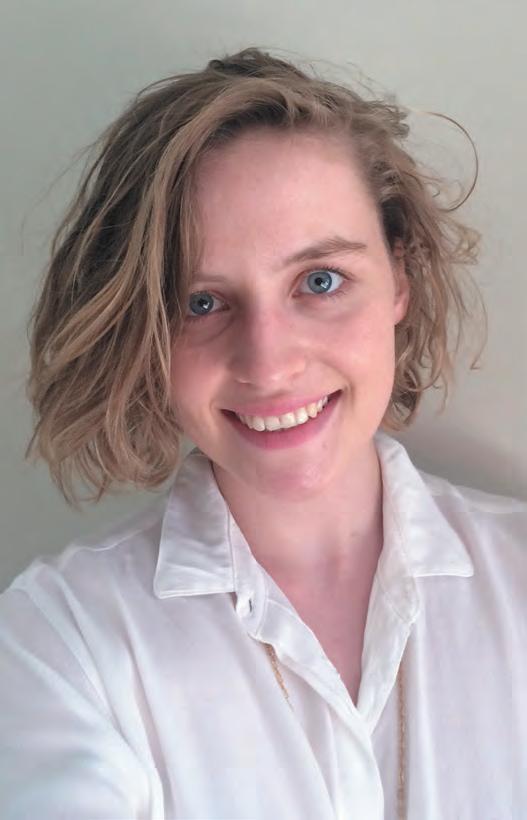
JHC Centre News 22
‘We leave a trail Of unsuspected contraband, Sometimes polluting, sometimes enriching Our adopted Home’
‘Smugglers’
migrants were having on the Australian community. Profiles of successful members of Australian Jewry were far-ranging, from professors and engineers to bricklayers and repairers. The book was well received by Calwell who, in the Introduction, called for Australians to read the book to combat antisemtism and anti-‘reffo’ sentiments which were brewing in the community. He also added that the war had taught people that ‘the world is too small…for racial and religious hatred of any kind.’
Last year, 2015, marked the 70 th anniversary of the end of the Second World War and the Holocaust. This anniversary invites us to reflect on the past and also consider how far we have come since then in regard to the acceptance of refugees and asylum seekers. Recent comments from the UNHCR, the global body for refugees, estimate that 4,000,000 refugees, half of them children, have fled Syria since the crisis erupted in 2011. This staggering number has led the UNHCR to describe the situation as one of the worst crises that it has dealt with since its inception in 1950. With millions of refugees fleeing persecution in their homelands, we should look at the successful experiences of those who had earlier fled Europe to settle and create rich and fulfilling lives in Australia. By casting our eyes back to the past and recognising the contributions which migrants and refugees have made to Australian society, perhaps our nation will become more tolerant and welcoming to those who risk their lives in hope of finding protection, freedom and, ultimately, happiness on our shores.
Willy Lermer OAM has lived in Melbourne for the last 65 years after docking in Port Melbourne on 5 March, 1950. After being liberated by American troops in Dachau, Willy worked as a translator and acquired a visa to migrate to the USA with his wife. However, as his sister-in-law could not obtain a US visa, Willy was not prepared to risk breaking up the family.
‘I had no family. I was alone so I thought: “Why would I separate sisters?”’ he said. So Willy gave up on his Hollywood ambitions to settle into life in Melbourne. He persevered with strict landlords who denied him the use of the shower, forcing him to bathe in public baths, missing out on jobs for not having ‘Australian experience’ and adapting to the early closing times of Australian shops and pubs. In the first two years he still toyed with the idea of moving to America or even back to Germany but was persuaded to stay in Australia. After 10 years he had saved enough money to buy a house in Caulfield. Over the years he also purchased a washing machine, a Morris Minor and even a greatly sought-after television set following the 1956 Melbourne Olympic Games.
Willy later had the opportunity to travel, visiting the United States, Canada and Europe. He never returned to Krakow, the city of his birth. ‘I didn’t want to go back to Poland. There was something in the back of my mind – if I go back to Krakow, where I lived for the first 15 years of my life, I would feel that I’m walking on streets soaked with blood. I lost my parents, my little sister, my aunts, my uncles, cousins, and we had been a very close family,’ he said.
In hindsight, Willy said that he would have liked to visit the Nazi extermination camp at Belzec to see where his family was murdered. Instead, however, he has donated a plaque at the JHC to honour them.
Halina Zylberman, who survived the war years in Poland on Aryan papers, said that coming to Australia as a wide-eyed 20-year-old was exciting, as she was able to embrace her Jewish identity. ‘I was happy, I was enthusiastic, I was young,’ she said. Halina’s visa application was assisted in part by the Australian Jewish Welfare Society (AJWS), and although widespread antisemitism in Poland prevented her from being homesick, some pre-war memories proved hard to leave behind. ‘I didn’t miss Poland; I missed my time in Poland. I was very happy in Poland as a child,’ she said.
The successes which Halina, Willy and Maria have been fortunate to experience are testament to the welcoming nature of Australians. This makes it all the more disheartening to consider the number of people who are actively being denied the opportunity to settle here.
Julian Burnside QC, one of Australia’s most prominent human rights and asylum seeker activists, said that a culmination of events and hard-line politics has led to Australia becoming ‘frightened’ of refugees and asylum seekers, spearheaded by the ‘Tampa Affair’ in 2001 which led to the creation of the ‘Pacific Solution’. Not only did this change the everyday Australian’s attitude towards asylum seekers, but it also led to the Australian government enforcing strict policies, breaching protocols of a range of Australia’s international human rights’ obligations. ‘We have had people locked up for years because they are asylum seekers. Not because they’ve done anything wrong, not because they’ve broken a law, not because they’re a risk to us, but because they are seeking protection,’ Burnside said.
The ‘New Australians’ have contributed so much to the Australian psyche and multicultural identity. It is of the utmost importance that as a nation we collectively denounce the inhumane treatment of refugees and asylum seekers and offer the same opportunities to the next generation of ‘New Australians’. If we fail to do so, our reputation as a fair and tolerant country, willing to give everyone a ‘fair go’, will be tarnished.
I find it apt to conclude with an excerpt from the 1948 New Australians handbook as it rings especially true: ‘If we look at the past, we see that each country which admitted refugees from political, religious, racial or other persecution, gained immensely by giving shelter to these unfortunates.’
Emer McCarthy, who completed her Bachelor of Journalism degree at Monash University at the end of 2015, was the recipient of the Irene and Ignace Rozental scholarship, consequently serving as an intern at the Jewish Holocaust Centre in 2015.
JHC Centre News 23
Photo: Emer McCarthy
JHC Social Club
Barbara Sacks
The monthly meeting of the Jewish Holocaust Centre (JHC) Social Club continues to be a highlight for Holocaust survivors, volunteers and guides, and their friends. Over the past months we have had a range of stimulating and informative speakers who never fail to generate searching questions and lively discussions.
Sydney-based writer and motivational speaker Cheryl Koenig OAM, accompanied by her father, Frici, addressed us about ‘My Australian story’. The 2009 NSW Woman of the Year who received her Medal of the Order of Australia for service to people with disabilities, their families and carers, is passionate about the importance of history in understanding ourselves. Her latest book, a family memoir titled With Just One Suitcase, pays homage to her father and her father-in-law, Istvan.
Eddie Tamir, director of the Jewish International Film Festival (JIFF) and, together with his wife Lindy, owner of the Classic, Cameo and Lido Cinemas, gave us a sneak preview of JIFF 2015 in October last year with his entertaining address on ‘Jewish International Film Festival (JIFF) 2015 – 60 new Jewish films from Israel and around the world.’
Our next speaker was Zvi Civins, teacher and educator and former Director of Education at the JHC. An avid traveller and amateur photographer, Zvi gave a stimulating talk titled ‘The Kokoda Track – its importance to Australia and to me’, a first-hand account of walking the track with his wife Marian in 2013.
Jamie Hyams spoke to us about ‘Latest Developments in Israel and the wider Middle East’. A Senior Policy Analyst with the Australia/Israel & Jewish Affairs Council (AIJAC), and a former councillor and mayor of the City of Glen Eira, Jamie is involved in analysing and monitoring developments in the Middle East, Asia and Australia and shared his extensive knowledge and insights with our group.
Julie Szego, lawyer and journalist, has worked at The Age for twelve years as a social affairs’ reporter, senior writer, leader writer and columnist. She wrote a monthly column for the Australian Jewish News for seven years, contributed to a book of essays on Australian Jewish culture and edited and interpreted her father’s 2001 memoir, Two Prayers to One God Her fascinating subject was ‘The story behind a miscarriage of justice’, the story behind the rape conviction of Somali refugee Farah Jama in 2008 which she documented in her book, The Tainted Trial of Farah Jama
The club regularly attracts between 60 and 70 people and welcomes you to join us for bagels and coffee, and for stimulating and lively discussion. We meet monthly on Thursday mornings at the Jewish Holocaust Centre.
For further information about the JHC Social Club, please contact Barbara Sacks on 0404 224 498.
1 (l-r) Marian Civins, Maya Lee, Clara Weis ,Zvi Civins and Barbara Sacks
2 (l-r) Lindy Tamir, Dita Gould, Barbara Sacks, Lusia Haberfeld and Eddie Tamir

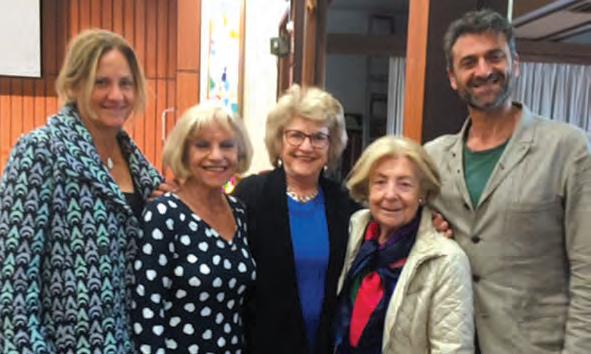
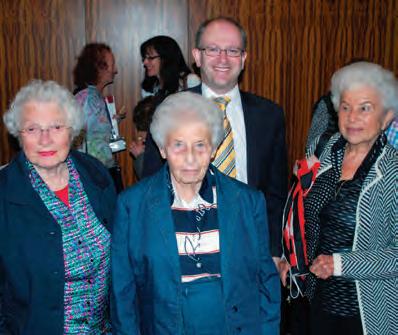
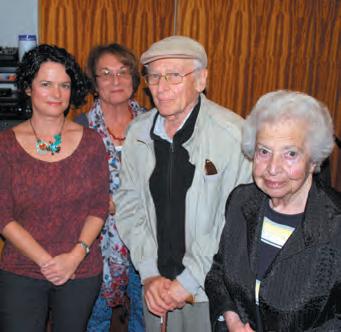

3 (l-r) Cheryl Koenig OAM, Frici Low and Barbara Sacks
4 (l-r) Julie Szego, Danielle Jelinek, George Svelger and Bella Meylikh
5: l-r) Saba Feniger, Eva Somogyi, Jamie Hyams and Lisel Singer
JHC Centre News 24
5 4 3 1 2
Friends of the Jewish Holocaust Centre
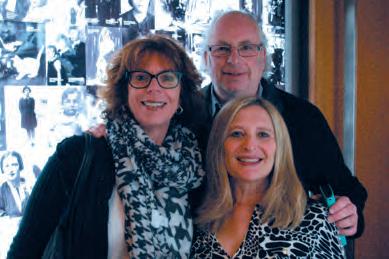
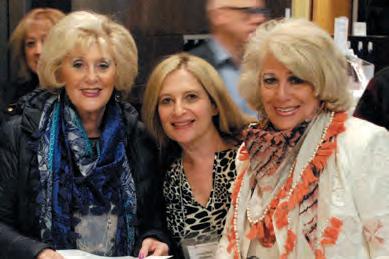
The Friends of the Jewish Holocaust Centre (JHC) organisation continues to support the social and educational programs of the Centre. In September 2015, we hosted a function for the ‘Jewish Refugees and Shanghai’ exhibition held at the JHC. Our guest speaker was Shanghai-born Sam Moshinsky, who treated the audience to an inspiring and entertaining account of life in Shanghai after the Second World War. The event was attended by over 130 people and we raised several hundred dollars for the Centre.

In October 2015, we held our first pre-wedding function in honour of the marriage of Lauren Spitalnic to David Majtlis. Lauren is past president of the Young Friends of the Jewish Holocaust Centre and the function, held in the home of Melinda Rotstein, raised $3,000 for the Centre. We thank Lauren and David for their generosity and hope other young people will be inspired to follow their example. Gary Ramler, who celebrated his 60th birthday with family and friends on Succot, kindly asked his guests to donate to the Centre in lieu of gifts, and we thank him too for his generosity.
We are pleased to have provided funding for photographic equipment to assist the Centre’s Archives Department with the digitisation and cataloguing of museum artefacts, and have also contributed to the much-needed new server.
We ended 2015 by assisting to run the Centre’s end-of-year function for staff, guides and volunteers, and were delighted to be able to offer the raffle prize of two tickets to Fiddler on the Roof As a result of our membership drive in September 2015, we now have more than 300 members. We hope to continue to increase our membership and to involve some new faces in our hardworking committee.
Become a Friend of the Jewish Holocaust Centre. Support the activities of the Centre.
The Friends of the Jewish Holocaust Centre plays an important role in providing financial support to the Centre through membership subscriptions, raffle book sales, sales of the Entertainment Book and social fundraising functions. To become a Friend of the Jewish Holocaust Centre, simply download and complete the form from www.jhc.org.au/ friends-of-the-jhc.html
For further information please contact Goldie Birch on (03) 9528 1985 or email goldiegb@bigpond.net.au.
JHC Centre News 25
1 (l-r) Goldie Birch, Henry Lawson, Sam Moshinsky OAM and Elly Brooks
2 (l-r) Lea Wolf, Goldie Birch and Lynne Samuel
3 (l-r) Ruth Frydman, Irving Birch and Goldie Birch
1 2 3
Goldie Birch

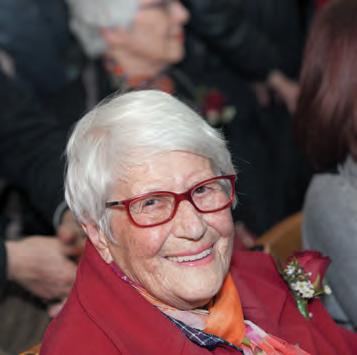
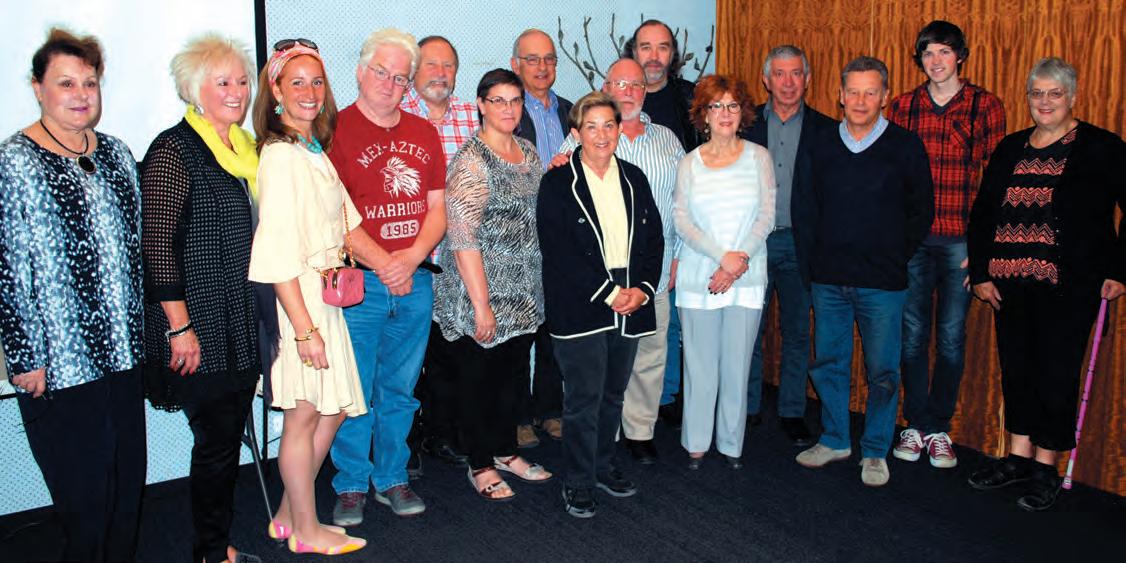



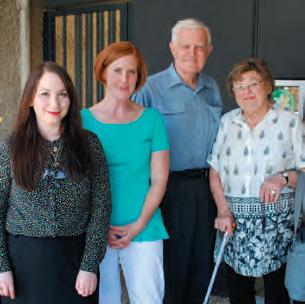
JHC Centre News 26
5
7
1 2 3 4
6
Seen around the Centre
1 (l-r) Michelle Malet, Adele Winter and Dr Abraham Winter
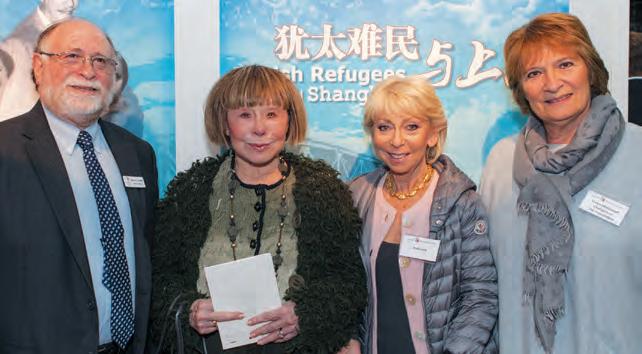

2 (l-r) Maria Lewit OAM, Jayne Josem and Prof Barbara Kirshenblatt-Gimblett
3 Lily Skall
4 2015 JHC Holocaust Education Course graduates with D r Bill Anderson
5 Jewish Holocaust Centre Board
6 (l-r) Dr Anna Hirsh, Michelle Malet, Dr Abe Dorevitch and Vera Dorevitch
7 Warren Fineberg, Rabbi Abraham Cooper, Helen Mahemoff and Edna Lipson
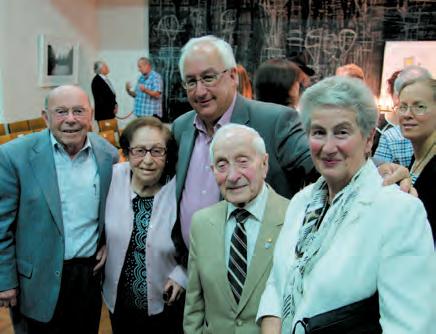
8 (l-r) Sue Hampel OAM, Warren Fineberg, Jeanne Pratt AC, Rosie Lew and Helen Mahemoff
9 (l-r) Lisa Phillips, Andrzej Folwarczny and Alexandra Dunwill
10 l -r) Phillip Maisel OAM, Freda Schweitzer, The Hon Michael Danby M P, Avram Goldberg OAM and Nina Bassat AM
11 Warren Fineberg, Jayne Josem and Dr Anna Hirsh with members of the Museum Accreditation Program (MAP) team
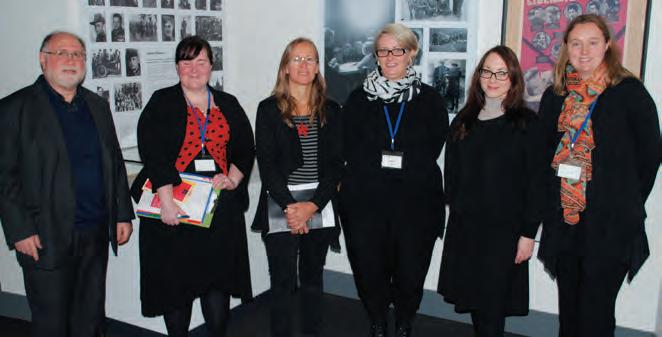
12 l -r) Simone Markus, Phil Symons OAM, Dr Norman Tendler, Pauline Gandel, John Gandel AO, Rabbi James Kennard, Vedran D rakulic, Nurit Davidson, Nicole Brittain, Lisa Phillips and Sue H ampel OAM.

JHC Centre News 27
8 9 10 11 12
The Jewish Holocaust Centre’s ‘Next Generation’

Around 100 people attended a milestone ‘Next Generation’ event at the Jewish Holocaust Centre. They toured the museum and heard the story of Abram Goldberg OAM, Holocaust survivor and long-term Board member. Third generation Board members David (Doov) Cohen and Richard Michaels spoke of the need for increased engagement from their p eers to ensure adequate succession planning for the Jewish Holocaust Centre in the long term. They plan to establish a young leadership group, as well as organising further events.
If you would like further information about the Next Generation, please contact Doov Cohen on 0412 718 422 or Richard Michaels on 0413 482 186.
1 (l-r) Darren Rubenstein, Joanna Rogers, Tammy Feldman, Simon Feldman, Danielle Rogers and Jamie Sutton
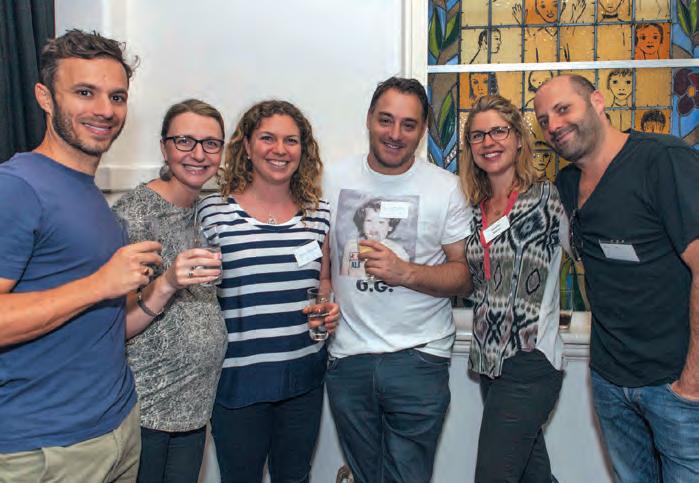
2 (l-r) Ronit Hoppe, Michelle Casper and Doov Cohen

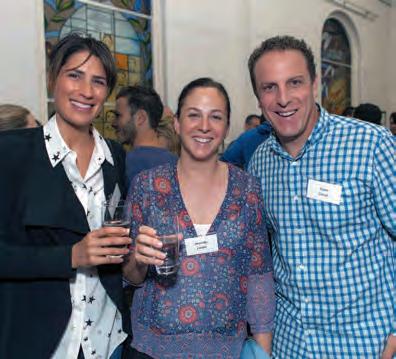
3 (l-r) Elli Smorgon and Andy Gild
4 (l-r) Doov Cohen, Abram Goldberg OAM and Richard Michaels
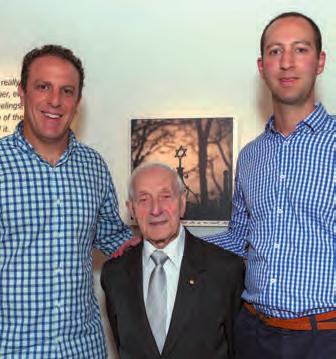
Become a Partner in Remembrance
The Jewish Holocaust Centre Foundation ensures the continued existence of the Centre and supports its important work. Funds raised through the Foundation are invested, with the earnings providing an ongoing source of income for the Centre to support its operations and programs into the future. For more information on how you can help support the Foundation and how your support will be recognised, please contact Helen Mahemoff, Chair of the Foundation on 0417 323 595 or Email: jhcfoundation@bigpond.com.
JHC Centre News 28
1 2
4 3
New acquisitions
Claude Fromm and Anna Hirsh
The following are new additions to the Jewish Holocaust Centre’s collection from July to December 2015. We thank the donors for their generosity:
1. Photograph of the family of the late Joel Furman, husband of the donor, and a small photograph of prisoners loading dead bodies onto railway carriages. Mr Furman was incarcerated in Buchenwald Concentration Camp, and many members of his family were murdered there.
Donor: Vivienne Furman
2. Collection of documents relating to Heinz Wolff and his family, who fled Germany in 1939 and were in Shanghai during the Second World War.
Donor: Heinz Wolff
3. Five drawings by German architect Hermann Baum, father of the donors, including an architectural plan of the Oranienburg (Sachsenhausen) concentration camp. The drawings were made after the Baum family fled Germany in the late 1930s.
Donors: Veronica and Martin Baum (and family)
4. A collection of documents and diaries belonging to the Libhaber family relating to the Chelm ghetto and labour camp in Poland. The donation includes three diaries in Yiddish written by Gita Libhaber, grandmother of the donor, and various Polish documents belonging to Simon and Stephanie Libhaber, parents of the donor.
Donor: Henrietta Herzfeld
5. Honorary citizenship ceremony program for Raoul Wallenberg. The ceremony was held on 6 May 2013 at Government House, Canberra. The program is signed by Prime Minister, the Hon Julia Gillard.
Donor: Office of the Prime Minister, Canberra.
6. A collection of documents and photographs belonging to Siegmund and Karoline Stern and their daughters, Else and Grete. Siegmund and Karoline were murdered in the Holocaust. Their daughters escaped to England via The Netherlands about six weeks before the outbreak of the Second World War.
Donor: Lana Zuker
7. First issue stamps of Mother Teresa, Nelson Mandela, and Raoul Wallenberg in card folder, part of the ‘Honoured by Australia’ series published by Australia Post. The Jewish Holocaust Centre (JHC) provided the image of the Hungarian yellow Star of David badge from the archives which was used in the Raoul Wallenberg stamp in this series.

Donor: Australia Post
8. Three original drawings and five editioned giclee prints from artist Lazar Krum’s Holocaust Series 1967-68. The drawings were inspired by the experiences of his father Samuel Krum, who fled from Poland to the Soviet zone.

Donor: Lazar Krum
9. Artwork: Ocean scene with two sailboats, made with inlaid wood on board. Created by Dr Benjamin Gomperts while he was in hiding from the Nazis at one of his patients’ homes in Amsterdam. Dr Gomperts was the uncle of Bep Gompert’s husband Herman, and the work is donated in memory of Carla von Stein-Gomperts, Herman’s late sister.
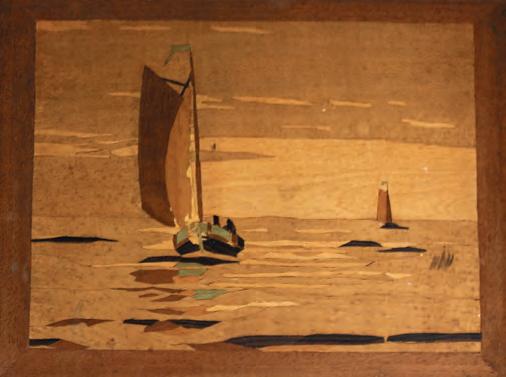
Donor: Bep Gomperts, volunteer in the JHC Archives
The Jewish Holocaust Centre (JHC) collection is a vital repository of Holocaust-era material. Artifacts, including photographs, objects and documents, are electronically catalogued, and stored in museum standard housings and environments to ensure their preservation for future generations. The JHC invites members of the public who have precious items relating to the Holocaust to consider donating them to our collection for safekeeping and as a contribution to historical research.
JHC Centre News 29
1 Raoul Wallenberg First Issue Stamp, Australia Post
2 Lazar Krum, Ghetto, Ink on Paper, from Holocaust Series, 1968-69
1 2 3
3 Dr Benjamin Gomperts: Untitled (Ocean Scene with Two Sailboats), inlaid wood (Second World War era)
BEQUESTS
Estate Gifts
We acknowledge the Jewish Holocaust Centre and Foundation bequestors for their generosity and vision. May their memory be a blessing.
Regina Adelfang
Erika Bence
Elza Bernst
Susan Blatman
Gitla Borenstein
Joseph Brown AO OBE
Majer Ceprow
Richard Charlupski
Bertha Fekete
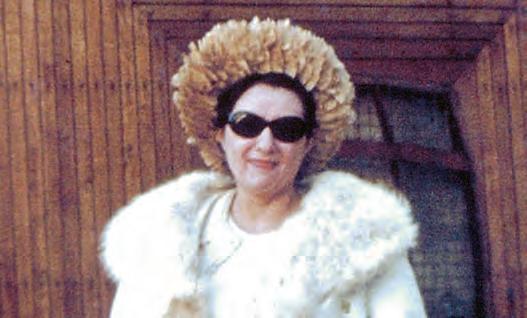
John Fox
Jakob Frenkiel
Cecilia Freshman
Romana Frey
Sara Frucht
Fania Gitein
Samuel Gnieslaw
Arnold Hacker
Bessie Heiman
Mendel Herszfeld
Magda Horvat
Sabina Jakubowicz
Betty Janover
Basia Kane
Thea Kimla
Lola Kiven
Leslie Klemke
Pinek Krystal
Nona Lee
Ivor Leiser
Ruth Leiser
Charlotte Lesser
Kurt Lewinski
Sara Liebmann
Julek & Ada Lipski
Abram Malewiak
Janina Marcus
Don Marejn
Anna Mass
Sonia Mrocki
Victor Muntz Kalman & Elka Bajla Parasol
Edith Peer
Nona Lee: the impact of giving
In 2004 the Jewish Holocaust Centre (JHC) received a very generous bequest from the Estate of Nona Lee. In recognition of this substantial gift, the Education Program for Secondary Students was named in her memory.
Nona Lee (née Rabinov), whose given name was Mindel (Minnie), was born in Melbourne in 1916, the eldest of three children. In 1933, after completing her schooling, Nona married Wolf Fink, whom she met at a football match. Wolf worked in his family’s woollen mill. As newlyweds, Nona and Wolf built a house in Kew. They had no children. Wolf was the brother of Leo, Syd and Jack Fink. Leo Fink was married to JHC co-founder and communal leader, Mina Fink. Leo and Mina Fink had two children, Nathan and Freda (Freiberg). According to Nathan, who knew Nona since he was a schoolboy, the extended Fink family was large and close.
Nona’s brother, Alan, served in the Australian Infantry Forces during the Second World War. He was captured in Singapore and became a prisoner-of-war. Don, the youngest sibling, studied medicine at the University of Melbourne. Nona worked as a
Elizabeth Peer
Lilian Renard
Gerda Rogers
Beatrice Rosalky
Hadasa Rosenbaum
Szmul Rostkier
Bencjan Rozencwajg
Irene & Ignacy Rozental
Leslie Sandy
Helen Sharp
Otto Shelton
Raymond Harry Shiller
Marianne Singer
Sara Smuzyk
Mary Starr
Georgette Steinic
Samuel Stopnik
Geoffrey Tozer
Josef Tyler
Chana Annette Uberbayn
Emanuel Wajnblum
Kathe Weisselberg
Ludvik Weisz
Pinkus Wiener
Ludwik & Rita Winfield
Chaya Ziskind
Sofia Zitron
volunteer during the war, becoming president of the Victorian Barracks Canteen Auxiliary. She organised fundraising balls to provide subsidised meals at the canteen for service personnel. In 1940 Nona commenced a Diploma in Social Studies at the University of Melbourne.
In 1946 Nona’s marriage with Wolf Fink ended and she moved to Sydney, where she owned and operated a garage together with her brother, Alan. During this time Nona met Norman Lee, a doctor who had studied at the University of Melbourne. They were married in 1950. In 1955 the marriage ended and Nona departed for the United Kingdom. She lived in Kent and established a small hotel and restaurant at Seven Oaks in western Kent. She also had success investing in the bond market.
Nona returned to Australia in 1985 and purchased an apartment in South Yarra. She established the first sporting scholarships at the University of Melbourne. Upon her passing, she generously included the Jewish Holocaust Centre as one of the beneficiaries of her estate.
The gift was extraordinary, as Nona Lee had no direct connection to the Centre, and it was made due to her close and special relationship with the Fink family and her respect for Mina’s work, in particular with young Holocaust survivors who arrived in Australia after the war without their own families.
The Nona Lee Education Program for Secondary Students has a far-reaching effect on so many students. Every day, students attending the education program learn not to hate and to stand up to injustice. Students are empowered through active learning during their visit and invariably leave with a deeper understanding of the real human tragedy that is the Holocaust. More than 21,000 students from one in three Victorian schools participate in the education program each year.
Bequests from friends and supporters like Nona Lee continue to play a vital role in sustaining the mission of the Jewish Holocaust Centre and helping to ensure that future generations will learn the lessons of the Holocaust. We are most grateful for Nona Lee’s incredible foresight in choosing to support the work of the Centre, and are delighted that our Education Program for Secondary Students bears her name and honours her memory.
JHC Centre News 30
Photo: Nona Lee
Edith Peer: a real Jewish heart
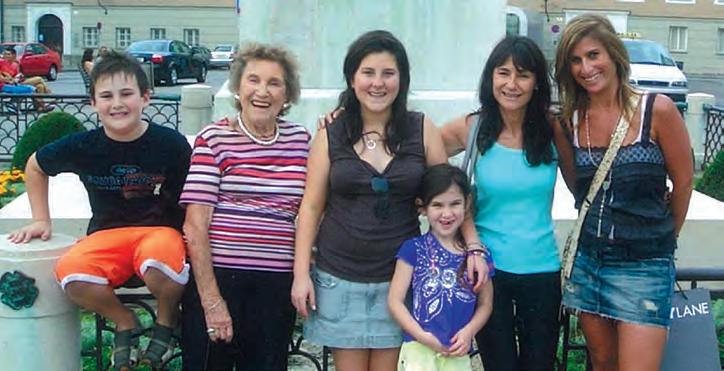
Edith Peer was born in 1921 in Vienna, the older child of Eugene and Eleanora Blumfeld. She had a younger brother, Kurt. The family lived above Eugene’s clothing shop. Edith made the most of Vienna’s rich cultural life: the parks, opera, theatre, food and more. That all ended in March 1938 when the Nazis annexed Austria.
Eugene was a successful businessman and proud Austrian Jew who had been awarded the Iron Cross for bravery after the First World War. When the Nazis marched into Vienna, he dismissed his family’s pleas to flee, as he believed they would be safe. However, on Kristallnacht in November 1938, his family’s fears came true. Eugene’s staunch loyalty proved worthless and he was transported to Dachau. Although he survived Dachau, Edith never saw her father again.
When her father was taken away, the strong-willed and independent Edith decided to save herself and to do everything possible to save her family. She registered herself on a Kindertransport to England, where she met a rabbi who assisted her in securing a place for her brother on one of the last Kindertransports to leave Europe. Her next task was to get as far away from Europe as possible. At the age of 17 she was extremely resourceful and, as she had no family outside Europe, she began writing to Jewish families around the world – strangers whose details she somehow procured – asking them to claim her and Kurt as relatives.
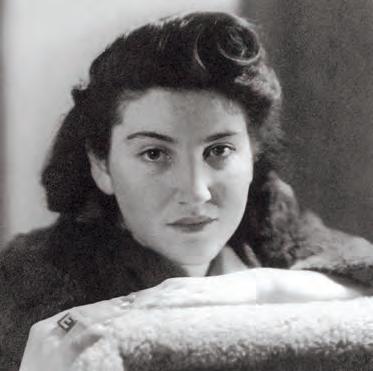
The Benjamin family in Melbourne responded and, six months after fleeing Vienna, Edith and Kurt came to Australia. She immediately began work to secure passage for her parents and extended family, but the outbreak of war made her task almost impossible. She later heard that her parents had fled to Yugoslavia and that her father had committed suicide by jumping from a train transporting Jews to a concentration camp, while her mother was murdered in Auschwitz.
Edith was 18 and Kurt 15 when they began their new life in Melbourne, not knowing English and with little support. Edith continued to work tirelessly to get her family out of Europe, and succeeded in bringing one cousin from Czechoslovakia to Australia. Needing to support themselves, Edith studied to be
a tailor while her brother joined the army and was posted to Albury for the duration of the war. After the war they opened K Barry and Associates, a schmatte factory in Hawthorn. In 1944 Edith married Ernest Peer. They had three children, Danny, Gary and Judy. Tragically, Danny died in a car accident in 1958.
Edith’s passion for life, the arts and business never waned. She was successful in business and became a mentor and advisor to many. She attended opera and theatre and was an avid reader and moviegoer. She felt a responsibility to help others, particularly in the Jewish community, and worked tirelessly with JNF, WIZO, B’nai Brith and The Emmy Monash Home, where she was treasurer and a board member for many years, and recognised as a ‘life member’ for her work.
Edith’s son Gary speaks glowingly of his mother and her achievements. He remembers a house full of visitors: ‘There was always a schnitzel for the many visitors who were asked to sit and eat and were happily served. It was a sanctuary that our naughty friends would run away from home to, knowing they would be warmly received and fed. Mum was a planner and a doer. She was no fence-sitter and she called it as it was. She was the most loyal and supportive of friends. If you did her or her family wrong, she would let you know about it in no uncertain terms. And she wouldn’t give “two hoots” about how you felt. She taught us to respect our elders, to be polite and well-mannered.’
Edith left many legacies through the work she did and the people she influenced with her infectious life-energy. Her generosity lives on in her children, who already have a strong history of community support in their own right. When asked to describe his mother, Gary’s succinct response is: ‘She had a real Jewish heart.’
The preservation of the memory of the Holocaust was important to Edith and, as she said to her children: ‘It doesn’t matter what you have, you always have to give.’ She was true to her word in life and after. The Jewish Holocaust Centre was one of many Jewish organisations named as recipients of a bequest from Edith. The Centre is grateful for her support and will honour her wishes by directing her generous gift towards our many areas of memory preservation – testimonies, artefact preservation and education.
For further information about leaving a bequest, please contact Michelle Malet at MichelleM@jhc.org.au or phone 9528 1985.
JHC Centre News 31
1 Edith Peer
2 Edith Peer and her family in Vienna
1 2
How you can support the JHC
The Jewish Holocaust Centre (JHC) is grateful for the meaningful and generous support of community members and friends. Together, we are continuing the fulfilment of the vision of Melbourne’s Holocaust survivors to create a centre for remembrance and education. In making a gift towards our important work, you can support either the Jewish Holocaust Centre or the Jewish Holocaust Centre Foundation (JHCF). Gifts to the Centre go towards operating expenses, specific programs or special projects. Gifts to the Foundation become part of its perpetual endowment fund. Every gift, large or small, will make a difference.
Partners in Remembrance and Major Donor Programs
In 2003, when the Foundation was established, the Partners in Remembrance and Major Donor Giving Programs were launched, to recognise the generosity of individuals and families who financially supported the Centre through the Foundation.
With over 300 Partners in the Program and more than 40 Major Gifts of $25,000 and above, the Foundation continues to thrive.
As part of our ongoing fundraising activities at the Centre, we are now expanding these programs to acknowledge significant donations to the Centre.
New donors will be able to designate whether they would like their donation to be directed to the Centre for annual operating needs or towards the Jewish Holocaust Centre Foundation as a gift in perpetuity.
Partners in Remembrance
Gold Partner $18,000
Silver Partner $10,000
Bronze Partner $ 5,000
In addition to Partners in Remembrance, gifts at the Major Donor level will now be recognised by the Centre as well as the Foundation in the following categories:
Major Donor Levels
Governor $ 500,000
Benefactor $ 250,000
Guardian $100,000
Custodian $ 50,000
Fellow $ 25,000
All donations are fully tax deductible and are payable over five years. Partners in Remembrance and Major Donors are acknowledged on the Donor Kiosk at the Centre and, in the future, new donors will be listed in Centre News and the Annual Report.
The Jewish Holocaust Centre Foundation ensures the long-term financial security of the Centre and supports and encourages the work of the staff and volunteers. The Foundation has been led since inception by Chairperson Helen Mahemoff who, together with an independent Board of Trustees, manages and governs the Foundation’s now-substantial endowment. Funds raised through the Foundation are invested conservatively, with an annual distribution providing an ongoing source of income for the Centre.
Two new giving programs
The Centre is pleased to launch two new giving societies to recognise our supporters.
Bequest Society
The JHC will now be honouring individuals who have ensured the wellbeing of the Centre by including a planned gift in their Estate. If you have already left the Jewish Holocaust Centre a bequest, please let us recognise your generosity with membership in our newly created Bequest Society. We greatly value your support and would be delighted to thank you during your lifetime. Members receive a special membership pin and are kept informed of JHC news and activities. Members are also formally acknowledged, with permission, in the Centre’s publications.
Circle of Remembrance - Annual Appeal
The Jewish Holocaust Centre relies on the generous annual support of community members and friends to preserve Holocaust memory and inspire visitors to combat racism, hatred and prejudice by fostering tolerance and understanding. The JHC receives no recurrent government funding.
Circle of Remembrance gifts provide indispensable annual support for the preservation of our collections and a broad range of educational and outreach initiatives for students, teachers, members of the public and the Holocaust survivor community.
Giving Levels:
$1,800-$4,999
$1,000-$1,799
$500-$999
$1-$499
All donations to Circle of Remembrance above $500.00 will be acknowledged in Centre News and the Annual Report. Association with the Circle of Remembrance is for a full calendar year following the gift date. The Centre has Deductible Gift Recipient (DGR) status and all donations of $2 or more are tax deductible.
To ensure the long-term sustainability of the Centre and its programs, please support the important work of the Jewish Holocaust Centre by joining the Circle of Remembrance. See the enclosed donation information to make a gift.
JHC Centre News 32
Specific Program Support:
It is also possible to designate major gifts to support a particular area or special project at the Jewish Holocaust Centre for a set period of time.
Education Programs
Each year the Jewish Holocaust Centre educates over 21,000 secondary school students. Over one third of all secondary schools in Victoria visit the Centre, and more than 500,000 students have attended educational programs run by the JHC since it opened. In addition to coordinating the school educational program and the Holocaust education training course for guides, the education department also provides public outreach. Our educators present at teacher association conference workshops on enhancing the delivery of Holocaust education through the use of specific texts, films and online learning resources. They provide educational resources for Australian teachers such as ‘Eyewitness:
The Survivor Voice’ and ‘Digibooks’ in collaboration with ABC Splash, as well as pre- and post-learning activities to enhance student visits. Donor support can assist the many activities of our trained educators.
The Philip Maisel Testimonies Project
The Jewish Holocaust Centre has over 1,300 video testimonies from Melbourne Holocaust survivors, as well as over 200 audio testimonies. These survivor testimonies provide eyewitness accounts of the Holocaust, as well as glimpses into the vibrancy of pre-war Jewish life in Europe. Support from donors can help improve the testimonies’ database, as well as the digital indexing of the collection to make it more accessible for researchers.
The Ursula Flicker Archival Collection
The Melbourne Holocaust survivor community has entrusted over 18,000 precious items to the Jewish Holocaust Centre. There are many highly significant artefacts including camp uniforms, official documents, photographs, correspondence, unpublished diaries, memoirs and artworks. Currently this unique collection is accessible to students, teachers, researchers, academics, genealogists and families of survivors. A major project currently underway is to launch the collection online so that these items of great historical value will be easily available to the worldwide audience of researchers.
Custodians of Memory
As we face the aging of our survivors and transition to new ways of imparting their stories, Custodians of Memory preserves their precious voices and transmits their stories to future generations. ‘Custodians’ are volunteer guides who learn individual stories of survivors to be able to share these stories with others. Custodians train by watching the survivors’ testimonies, reading their published biographies or memoirs and by learning commonly asked questions.
More support opportunities
Exhibition Sponsorship
Each year the Centre attracts large audiences to its exceptional temporary exhibitions, which receive widespread publicity throughout Melbourne. Sponsorship of these premier opportunities offers the highest level of visibility and close association with Australia’s only dedicated Holocaust museum and educational institution. Sponsors are vital partners in mounting high-quality exhibitions ‘Jewish Refugees and Shanghai’, ‘Besa –The Promise’, ‘Facing the Past, Anne Frank: A History for Today’, and ‘The Rescuers’ were all made possible through the generosity of individual and corporate philanthropy.
The Centre works with its corporate and individual sponsors to maximise benefits. Offerings include:
• Prominent corporate/individual acknowledgment
• E xclusive access to special events
• Opportunities for clients and employees, including events and private tours
• Brand visibility through acknowledgment on our website and print publications
Simcha Donations
When planning a birthday, bar/bat mitzvah, wedding or anniversary consider asking friends and family to donate to the Jewish Holocaust Centre instead of giving presents. Donations in lieu of gifts to support Holocaust education and remembrance are a meaningful way to mark a special occasion.
You can also acknowledge someone who has made a difference in your life with a Simcha Donation. The person you are paying tribute to will be notified that you have made a donation in their honour.
Upcoming Capital Appeal
We shall soon be embarking on a major building project to more fully accommodate the record number of visitors we receive each year and allow us to remain positioned as one of the significant Holocaust centres in the world.
The Centre will continue to permanently house and preserve Melbourne’s Holocaust testimonies, archives and artefacts, as well as provide increased space for education, research, memorialisation and reflection. This exciting expansion project will serve the Centre’s needs for decades to come. Major Gift Naming Opportunities will be available.
All program supporters receive acknowledgment in publications relating to the program on an annual basis, as well as inclusion in Centre News and the Annual Report donor listings.
For additional information on any of the above items please email Michelle Malet, Director of Foundation and Director of Advancement at MichelleM@jhc.org.au or phone (03) 9528 1985.
JHC Centre News 33
Many thanks: Jewish Holocaust Centre and Jewish Holocaust Centre Foundation supporters
We would like to express our sincere gratitude and appreciation to all of our donors – your support has made a significant impact and continues to allow us to preserve Holocaust memory and teach the important lessons of the Holocaust. This listing includes donations to the Foundation or the Jewish Holocaust Centre of $500.00 and above from 1 January 2014 to 1 January 2016.
Thank you for your support.
Michael & Helen Abeles
Raymond Abrahams
Norman & Ruth Abrams
Leonie Allan
Roseanne Amarant
Jeffrey Appel OAM & Sue Appel
Arnold Bloch Leibler
Evan Arnott
Peter Avery & Vicky Vidor
Mark & Kerryn Baker
Bank of Melbourne
David Bardas
The Basin Theatre Group Inc.
Andrew & Natalie Bassat
Robert Bassat &
Nina Bassat AM
Sabbie Berger
Ted & Miriam Berman
The Besen Family Foundation
Nathan & Jenny Better
John & Mooky Bialylew
Binks & Associates Pty Ltd
Irving & Goldie Birch
Daryl Blashki
Greg & Julie Blashki
Philip Bliss OAM & Andrea Bliss
Barry & Lorraine Bloom
Joey & Julie Borensztajn
Tom & Nuritt Borsky
Philip & Vivien Brass
Allen & Marika Brostek
Mick & Marion Brott
Brott Enterprises
Diana Burgess
Joe & Pam Bursztyn
Bernard & Helen Carp
Brandon & Nicki Carp
Eve Casper
Michael & Carol Casper
George & Freda Castan
Richard & Sue Castan
Isi & Danielle Charak
The Estate of Richard Charlupski
Mark & Peggy Chaskiel
Jack Chorowicz & Lyla Burston
Adrian & Hilary Cohen
Anthony & Louise Cohen
Avi & Belinda Cohen
Ivan & Shirley Cohen
Jonathan & Jessica Cohen
Matthew & Lieba Cohen
Trevor & Heather Cohen
Michael & Michelle Coppel
Lady Anna Cowen AM
Michael Danby MP & Amanda da Costa
Tom & Evie Danos
Ian & Yvonne Davis
Rosie Davis
Tony & Rochelle Davis
Deakin University
Michael Debinski
Ron & Judy Dodge
Abe & Vera Dorevitch
Colin & Debbie Edwards
Elton & Fineberg Family
Mark & Hannah Fagenblat
Susan Fajnkind
Ian & Yvonne Fayman
Ken & Lisa Fehily
Alan & Yvonne Feil
Raffi & Rosalie Feldman
Simon & Tammy Feldman
Jack & Lotti Felman
Nathan & Elly Fink
The Leo & Mina Fink Fund
Alan Finkel AO & Elizabeth Finkel
Vann & Beata Fisher
Gabor & Janina Fleiszig
Mark & Natasha Fleiszig
Joe & Glenda Flinkier
Fonda Family Charitable
Foundation
Peter & Anita Frayman
David & Leah Freilich
The Estate of Jakob Frenkiel
Vivienne Fried
Michael & Vikki Friedman
Norman Fryde
Sid Gaddie & Sara Gold
The Gandel Family
Gandel Philanthropy
Mark & Judy Gandur
Ian & Rita Gelbart
Glen Eira City Council
Abe Goldberg OAM & Cesia Goldberg
Leigh & Yvonne Goldbloom
Goldie Nominees Pty Ltd
The Jack & Ethel Goldin
Foundation
Phil & Ingrid Goldman
Graham & Deborah Goldsmith
Alan & Pam Goldstone
Alex & Sharona Goodman
Philip & Raie Goodwach
Vicki Gordon
Tom & Jenny Gorog
Wayne Green
Jack Gringlas OAM & Diane Gringlas
Robert & Pauline Grodski
Louis & Marilyn Gross
Esther Grynspan
Ed & Ada Gurgiel
Jack & Judy Gutman
Lusia Haberfeld
Dennis & Suzanne Hain
Alice Halasz
George Halasz
Bernie & Melma Hamersfeld
Alex Hampel & Sue Hampel OAM
Robert Hanner
Jack Hansky AM & Paula Hansky OAM
Amir Harel & Judy Carman
David & Lilly Harris
Lawrence & Gene Harris
Gary & Sue Hearst
Joseph & Judith Hellen
Highpoint Property Group
Gabor & Deborah Hilton
Solly & Carol Hofman
Katy Honig
Josh & Ronnit Hoppe
Rachel Hornung
Michele Huppert
Aviva Hyman
Michael Irlicht & Bella Irlicht AM
The Peter Isaacson Foundation
Paul & Susie Ivany
Arnold & Ewa Jacobson
Myer & Genia Janover
Les & Kathy Janovic
Leon & Tosha Jedwab
Vernon & Sandra Jedwab
Michael & Danielle Jelinek
Jetmaster (Vic)
Benjamin & Sharona Jotkowitz
Charles & Leah Justin
Justin Kabbani
Mark & Sarah Kagan
Joseph Kalb
Floris Kalman
Henry & Vivienne Kalus
Michael & Sue Karp
Walter & Veronica Kastelan
Joe & Yvonne Kay
Andrew Kaye AM & Judy Kaye
Leon Kempler OAM & Ilana Kempler
Simon & Julie Kessel
Jeff & Ruth Kestenberg
The Estate of Thea Kimla
Stephen & Suzie Kleid
Ken & Carol Klooger
Judy Kluska
David & Bindy Koadlow
Steven Kolt & Francis Prince
Mel & Judi Korman
Larry Kornhauser
Alan & Rocky Kozica
JHC Centre News 34
Henryk & Emma Kranz
Ashley & Leigh Krongold
Dinah Krongold
Sue Krongold
Sam & Lea Kurc
Danny & Rolene Lamm
Barry & Barbara Landau
Sally Landman
Henry Lanzer AM & Janette Lanzer
Stephen & Eva Layton
Silvana Layton
Sylvie Leber
Eva Lehner
The Estate of Ruth Leiser
Charles & Annette Leski
Michael Levick
Barry Levy & Leah Kaplan
Barry & Elana Lewin
Phil & Sue Lewis
The Bori & Helen Liberman
Family
Eva Light
Ian & Liz Light
The Estate of Julek & Ada Lipski
Lowe Lippmann Chartered Accountants
Mr & Mrs D Lustig
Karin MacNab
Anthony Mahemoff
Arnold & Dani Mahemoff
Joel & Neda Mahemoff
Jeffrey Mahemoff AO & Helen Mahemoff
Philip Maisel OAM
David & Linda Mandel
The Estate of Don Marejn
Ignacy Marek
Ezra May
Brian McCann
Joe & Gisella Mel
Margot Melzak
Richard Mereine
Alan & Irene Messer
Zac Miller
Henry Miller & Natalie Miller AO
Dean & Kate Mohr
Moniton Pty Ltd
Henry & Roslyn Monkus
Mark Montag
Abe & Doris Montag
David & Helen Moses
Arnold & Susie Moss
Peter & Anat Nadler
Michael Naphtali AM & Atida Naphtali
Dennis & Fairlie Nassau
Leo & Rhonda Norich
Richard & Theddy Nossbaum
Barry Novy & Sue Selwyn
Miriam Orwin
Tom Osborn & Judy Rassaby
Outdoor Fitness Hub
Gerard & Lil Pearce
Gary & Hana Peer
Gary Peer & Associates
The Estate of Edith Peer
Andrew Peterfreund
Henry & Marcia Pinskier
Nathan & Susan Pinskier
Evelyn Pose
The Pratt Family Foundation
Romy Prins
Lola Putt
Harry Redner
Alan Reid & Elly Brooks
Ralph & Ruth Renard
Alex & Judy Resofsky
Michael & Nicole Rich
Darren Rockawin & Nicki Pick
Anthony & Shoshanna Rockman
Sean Rockman & Pauline Rockman OAM
Richard & Roslyn Rogers
The Estate of Beatrice Rosalky
Jack & Annette Rosen
Paul & Sheryl Rosen
Peter Rosenberg
David Rosenblum
Julian & Vivien Rosenfeld
Benny Rosenzweig & Alice Peer
Sonney Roth & Emily Slade
The Estate of Irene & Ignacy Rozental
Ester Rubenstein
Lou & Shirley Rutman
Renny & Lily Rychter
Robert & Samantha Rychter
Leo Sambor
Perry Sambor
The Estate of Leslie Sandy
Yvonne Sansone
William Sasse & Barbara Fih
Albert Sattler
Steven Scheuer
Freda Schweitzer
Scott Winton Insurance Brokers
Sam & Judy Seigel
Danny & Anita Selzer
Leon & Vivienne Serry
Greg Shalit & Miriam Faine
Shanghai Jewish Refugees Museum
The Estate of Helen Sharp
Corina Sharrock
Gideon & Barbara Shaw
Jack & Lesley Silberscher
Maurice & Judy Silman
Les & Azriel Silpert
Eric & Annie Silver
Mary Singer
The Estate of Marianne Singer
Graham & Mary Slade
Mandy Slade
Sam Smorgon AO & Minnie Smorgon
The Victor Smorgon
Charitable Fund
The Jack & Robert Smorgon Families Foundation
David Smorgon OAM & Kathie Smorgon
Helen Sokolski
David Southwick MLA & Hayley Southwick
Graeme Southwick OAM & Suzanne Southwick
Fleur Spitzer
The Estate of Mary Starr
Lionel & Brenda Steinberg
John & Suzanne Steiner
Stodart Development Pty Ltd
Bernie Stone
The Estate of Samuel Stopnik
The Sunraysia Foundation
Brett & Camille Sunshine
John & Irene Sutton
Eva Sweet
Theo & Shirley Sweet
Alan Synman
Sarah Szental
Stephen & Debbie Szental
Regine Szmulewicz
Ron & Sarah Tatarka
Philip & Aviva Teperman
Frank Tisher OAM & Miriam Tisher
Lynn Trayer
Stan Tremback & Gloria
Rubenstein
David Ungar & Julie Lustig
Ron & Sue Unger
Max & Pebbie Wald
Sam Webb
Alan & Caroline Wein
The Werdiger Family Foundation
Vivien Wertkin
Jeffrey Wiener
David & Alison Wiesenfeld
Dennis & Tauba Wilson
Adele Winter
Tommy & Rachel Winter
Simon & Lisa de Winter
Colin & Roe Wise
John & Bronia Witorz
Morry & Paule Wrobel
Godel & Rosa Wroby
Phillip & Miriam Zajac
Abe & Marlene Zelwer
Braham & Andrea Zilberman
Mark & Lana Zuker
Simcha Donations
We are pleased to add our Mazal Tov to the following people who requested gifts to the Jewish Holocaust Centre and Foundation in lieu of gifts on their special occasion. The Simchas listed occurred between 1 January 2014 and 1 January 2016.
Tuli Bleich’s 90th Birthday
Rachel Cymbalist’s Bat Mitzvah
Joe De Haan’s 92nd Birthday
Wolf Deane’s 90th Birthday
Saba Feniger’s 90th Birthday
Riley Fleiszig’s Bar Mitzvah
Jack Fogel’s 90th Birthday
Abe Goldberg’s 90th Birthday
Diana Kahn’s 90th Birthday
Linda Kras’ 60th Birthday
Tuvia Lipson’s 90th Birthday
Zac Miller’s Bar Mitzvah
David Prince’s 90th Birthday
Fryda Schweizer’s 90th Birthday
Lauren Spitalnic’s Pre-wedding
Richard Strosberg’s 85th Birthday
Jadzia Warman’s 90th Birthday
If a name has been misspelled, omitted, or listed improperly, please accept our deepest apologies and contact Michelle Malet on (03) 9528 1985 so that we may correct our records.
JHC Centre News 35
A letter to Ada
Indigo Erez
Dear Ada
I am sitting beneath the trees of a free place, where your light shines through the cracks in the branches, and I’m thinking of you. Unfortunately, I hardly ever ponder about you, even though I wish I did. I wish I could remember your glow every second of every day but I know that I can’t. Sometimes I remember you when I see my Zaida, your brother. And I always think of you when I look into the dark brown eyes of my older sister, Ebony. I seek your light there; everybody says your eyes looked just like hers. You see, Ebony was given your name – Ebony Ada Erez. I’d always been jealous of that. But when I was seven years young – the age when you perished, the age you were when you were forced into a small room and they turned on the poisonous air, the age you were when you took your last decrepit breath – I always thought about you and the light you possessed. Then I used to think about the games you might have played. I thought about how scary it must have been the day the Nazis came.
Now that I am older I think about you differently. I think about the
darker things, the fearful thoughts. I think about your bones and beauty falling off the edge into darkness. I think about your light falling with you. I think about your death being more than just a number, being more than just one of the six million.
So, my dearest Ada, I am writing to you to let you know that I do remember... and that I will never forget. I’m sorry that I could not read this to you on my own but I hope you understand. Not everybody is as brave as you were. Dear Ada, my light was faded today and I know yours was put out forever and taken away. So please, just for me, if I ever forget you, stand before me, open my eyes, and I promise I will finally see. Good night Ada.
With all my light Indigo
Indigo Erez is the sixteen-year-old granddaughter of Holocaust survivor and Jewish Holocaust Centre volunteer Gary Gray. Her great aunt Ada, Gary’s sister, was murdered in Auschwitz in 1943 when she was seven years old.
Mazal Tov
Engagements
To Ariella Leski on her engagement to Josh Lipshutz
To Bella Meylikh on the engagement of her grandson Joseph Rich to Rochelle Ben-Simon
Marriages
To Sara and John Berhang on the marriage of their son Danny Berhang to Romy Sachwald
To Cesia and Avram Goldberg on the marriage of their granddaughter Nastassja Bornsztejn to Dean Kuran
To Marion and Victor Mazjner on the marriage of their daughter Jacqui Majzner to David Mileikowski
To Rosi and Sean Meltzer on the marriage of their daughter Natalie Meltzer to Adam Porat
To Suzie and Gaby Nozik on the marriage of their grandson Joseph Rogers to Kira Rickards
To Eva and Allan Rutman on the marriage of their son Josh Rutman to Dani Baton
To Frances Ser on the marriage of her son Joel Ser to Ariella Mac
To Mary and Peter Stawski on the marriage of their daughter Danielle Stawski to Robert Frost
Birth
To Anita and Peter Frayman on the birth of their granddaughter Amelia Mordech
To Sue and Alex Hampel on the birth of their granddaughter Andie Hampel
To Pauline Katz on the birth of her great granddaughter Yael Rose Katz
To Ann and Yehuda Kabillo on the birth of their grandson Aviv Kabillo
To John Lamovie on the birth of his great grandson Chaim Dickstein
To Sue and Phil Lewis on the birth of their granddaughter Olivia Lewis
To Tuvia Lipson on the birth of his great granddaughter Ala Lipson
To Helen and Jeffrey Mahemoff on the birth of their grandson Ellis Mahemoff
To Evan and Stan Marks on the birth of their great grandson Aubrey Roberts
To Esther Michalowicz on the birth of her great grandson Eden Weinberg
To David Prince on the birth of his great granddaughter Rosie Steinhardt
To Aysa and Wolf Deane on the bat mitzvah of their granddaughter Nicki Issko
To Sarah and Paul Grinwald on the bar mitzvah of their grandson Braydon Lustig
To Tammy and Haim Reznik on the bar mitzvah of their son Zohar Reznik
Birthdays
To Jayne Josem on her 50 th birthday
To Lena Fiszman on her 60 th birthday
To Susie Kleid on her 60 th birthday
To Sue Unger on her 60 th birthday
To Moshe Ajzenbud on his 95th birthday
To Tuvia Lipson on his 90 th birthday
JHC Centre News 36
Bar Mitzvahs
Condolences
To Dorothy Dobia on the death of her husband Frank Dobia
To the family of Sonia Kempler on her death
To the family of Lusia Lenk on her death
To Ariella Leski on the death of her grandfather George Leski
To Tuvia Lipson on the death of his wife Miriam Buchbinder
To Pam Maclean on the death of her mother Anne Kleimann
Phillip Maisel Testimonies Project
The Jewish Holocaust Centre has over 1,300 video testimonies as well as over 200 audio testimonies in its collection. These provide eyewitness accounts of the horrors of the Holocaust, as well as glimpses into the vibrancy of pre-war Jewish life in Europe. The collection is widely used by researchers and students of oral history, the Holocaust and a variety of other disciplines.


If you would like to give your testimony or know of someone who is interested in giving a testimony, contact Phillip Maisel.
Phone: (03) 9528 1985 or email: testimonies@jhc.org.au
To Eva and Allan Rutman on the death of their mother-in-law and mother Nusia Rutman
To Lisa Slam on the death of her husband Zische Slam
To the family of Max Stern AM on his death
To the family of Mietek Silver on his death
1198 Toorak Rd

Camberwell Vic 3124
Telephone: (03) 9804 0888
Facsimile: (03) 9804 0322
Website: www.morco.com.au
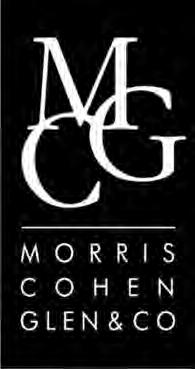
CHARTERED ACCOUNTANTS
Contact – Martin Artenstein
JHC Centre News 37

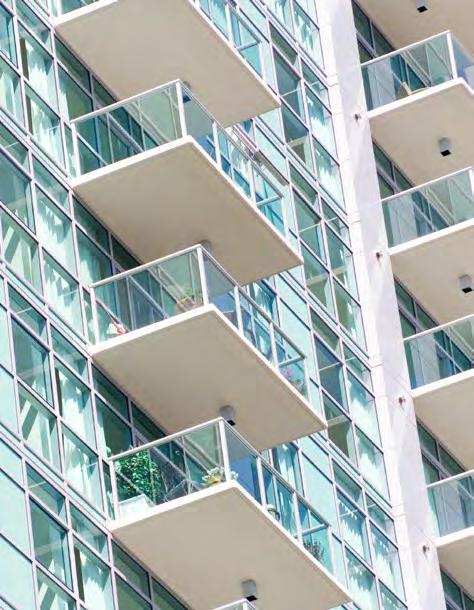

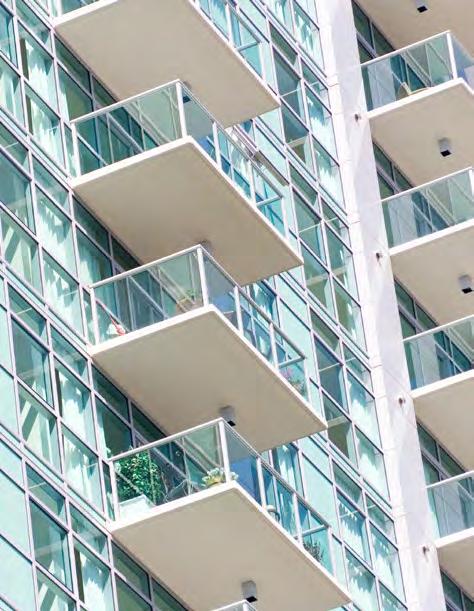
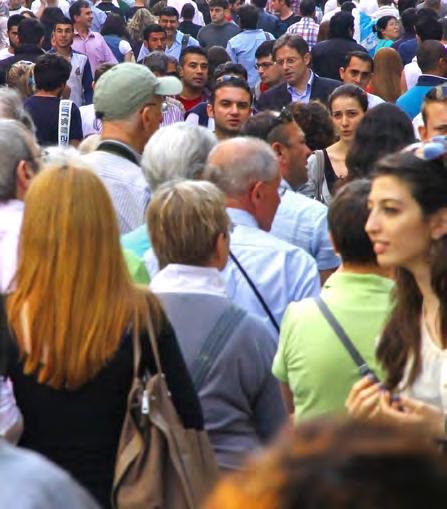

JHC Centre News 38 7331 Scott Winton - Jewish Holocaust Centre ad.indd 1 26/02/2015 11:28 am
Triple treat
Gary
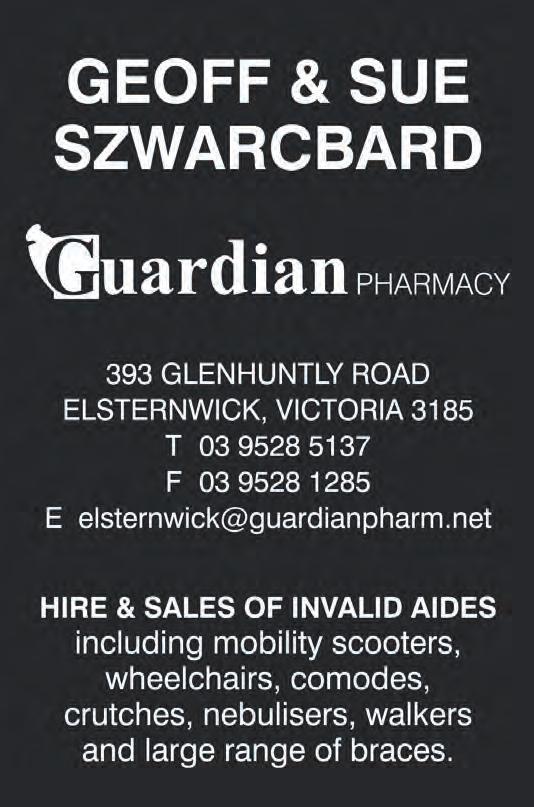

JHC Centre News 39
Peer & Associates is growing! Our third office is now open. With prominent office locations in Caulfield, St Kilda and now Carnegie, we’re triple the size. This is the biggest news in our company’s history since winning the REIV Large Residential Agency of the Year Award. If you’re thinking of selling, call us for prompt service all over Melbourne. 348 Orrong Rd Caulfield Nth 9526 1999 55 Inkerman Street St Kilda 9066 4688 42 Koornang Rd Carnegie 9563 1666 garypeer.com.au

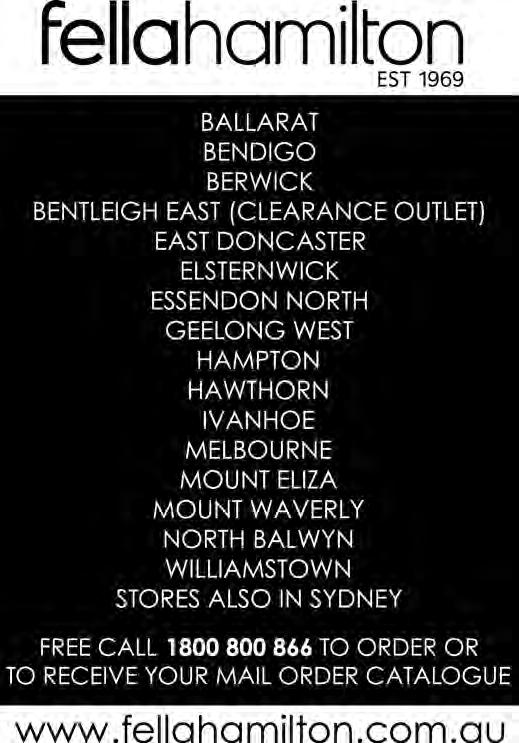


JHC Centre News 40 ADVERTISING If you would like to advertise in this section please contact Reuben Zylberszpic Email: ReubenZ@jhc.org.au Phone: (03) 9528 1985 With Compliments KATZ SILVER LAWYERS Suite 1, 71 Kooyong Road, Caulfield North 3161 Ph: 8508 8300 Fax: 8508 8399 Conveyancing, Wills & Estate Leases, Litigation and Business Law
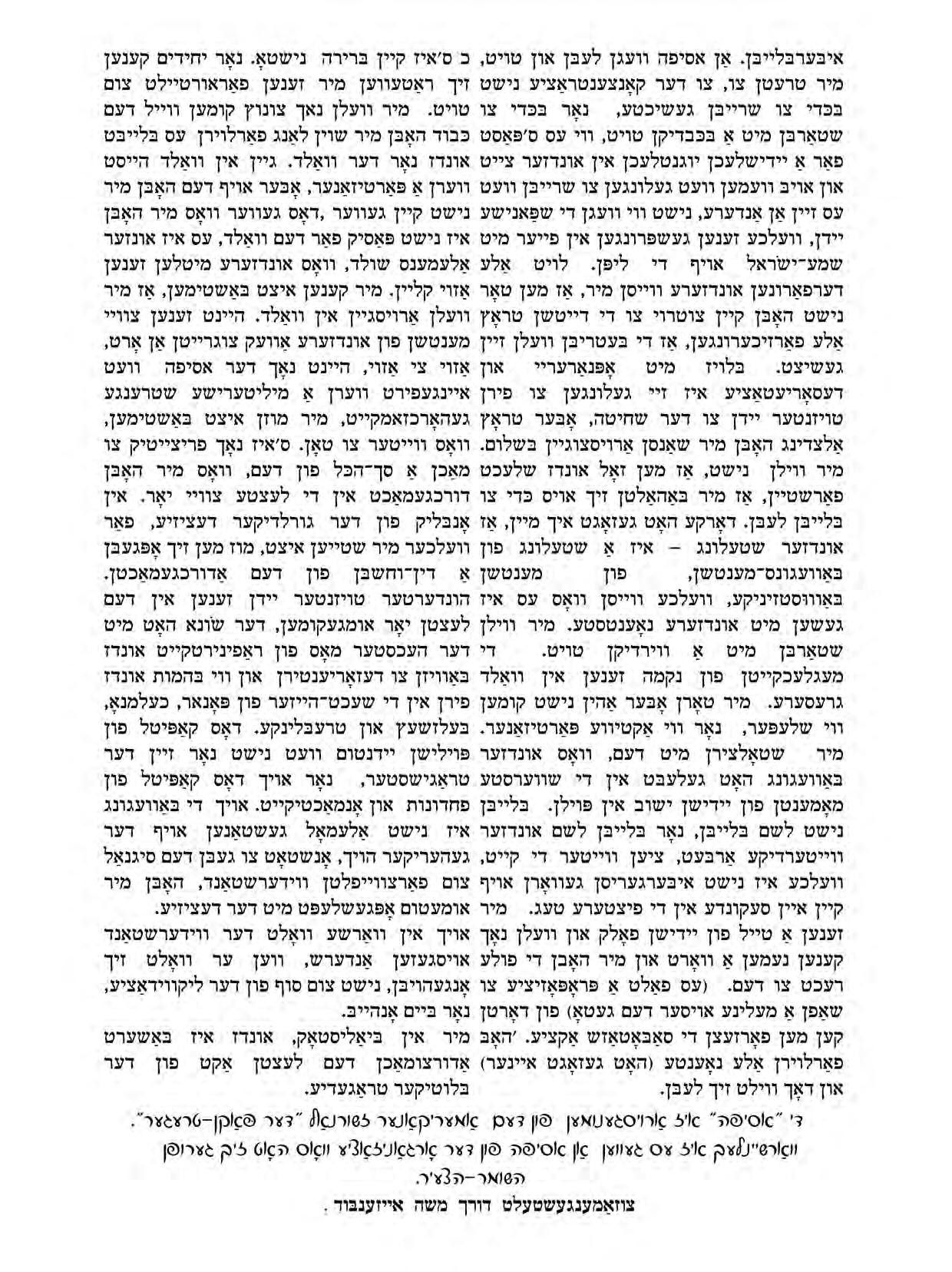
JHC Centre News 41

JHC Centre News 42
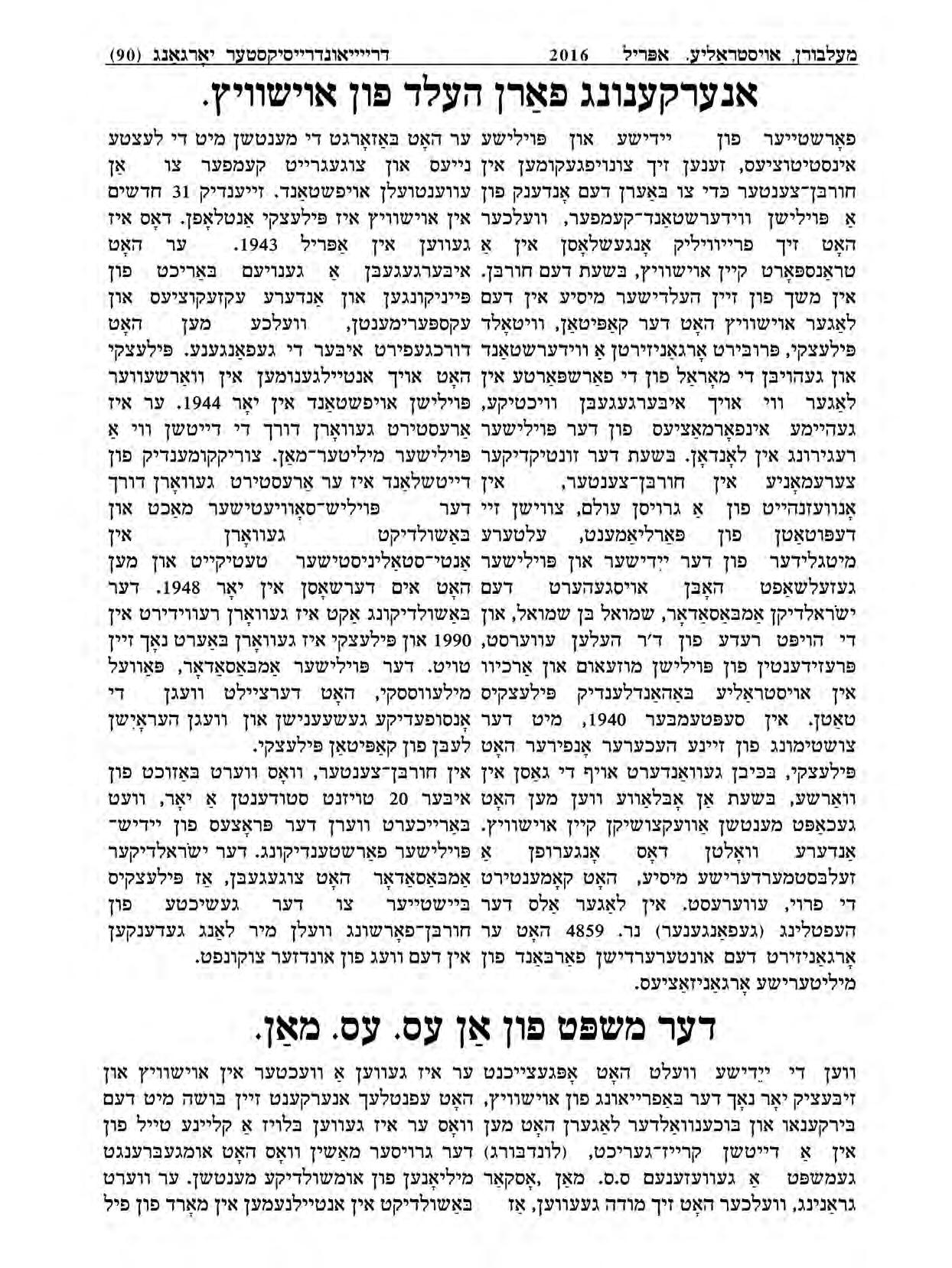
JHC Centre News 43
April 2016 Jewish Holocaust Centre



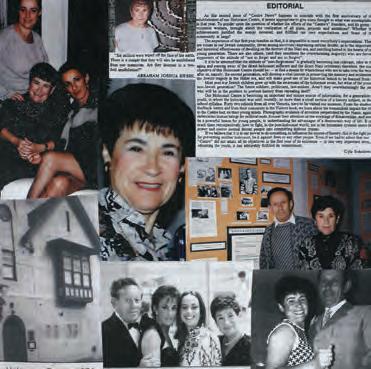
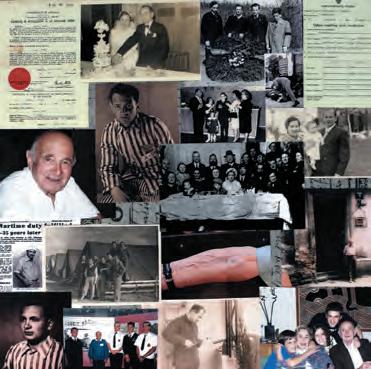

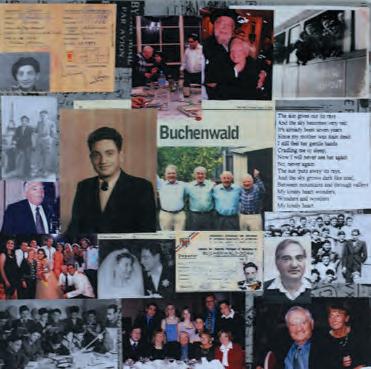
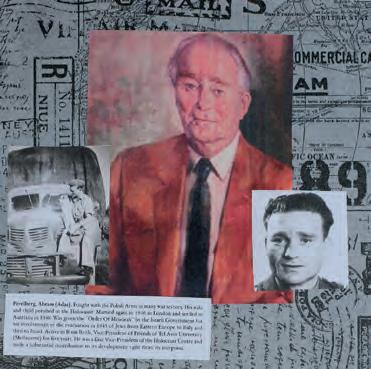
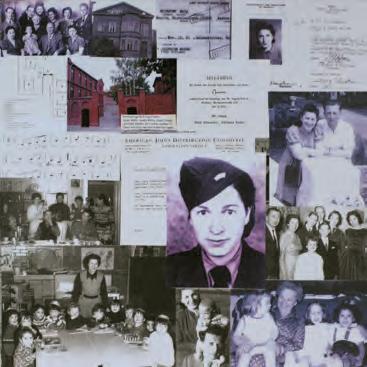

Registered by Australia Post. Publication No. VBH 7236
Shimon Michalowicz
Abraham Kolski
Abraham Perelberg
Jacob Schnall
Maly Kohn
Cyla Sokolowicz
Israel Bron
Ben Kamieniecki
Max Zylberman
Collages created as part of the Memory Reconstruction workshops held at the Jewish Holocaust Centre in December 2015.




































 Written by Deakin University academics Steven Cooke
Written by Deakin University academics Steven Cooke




























































